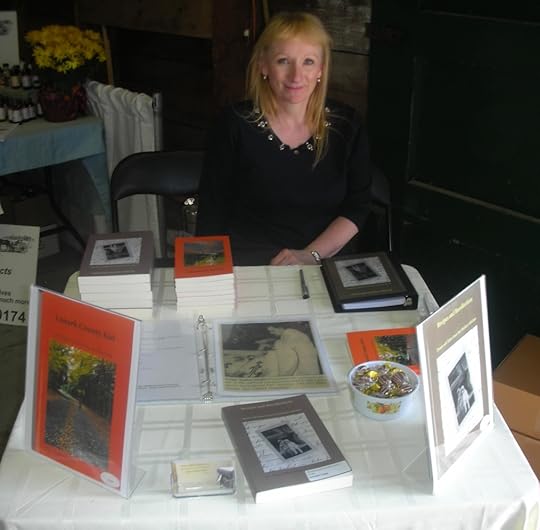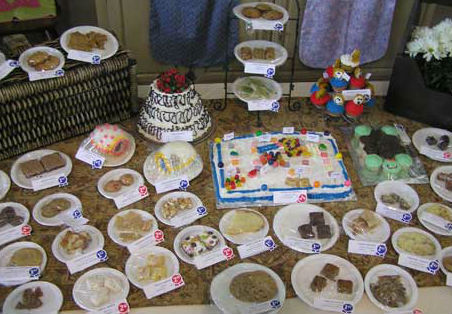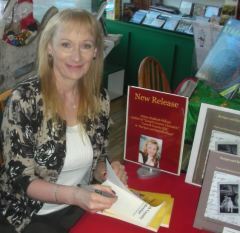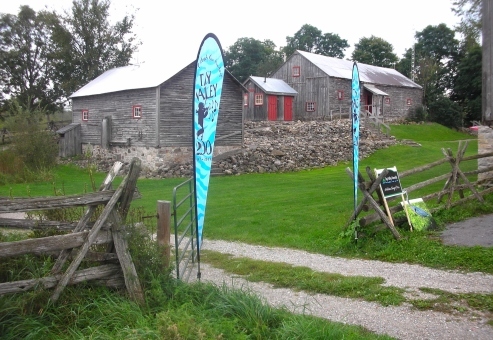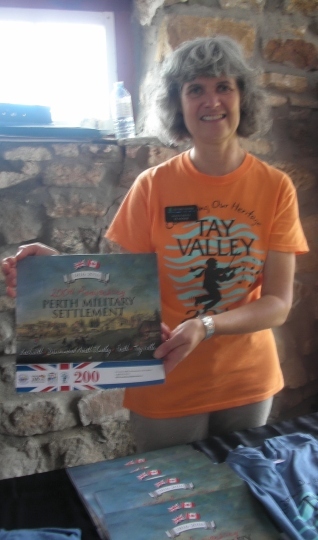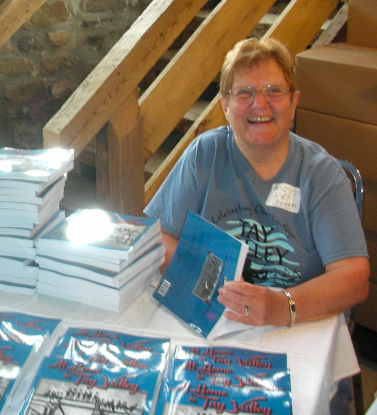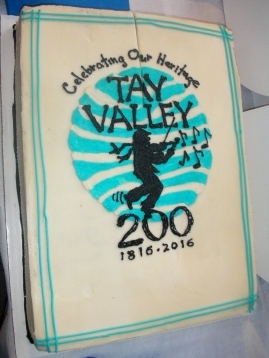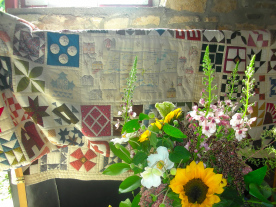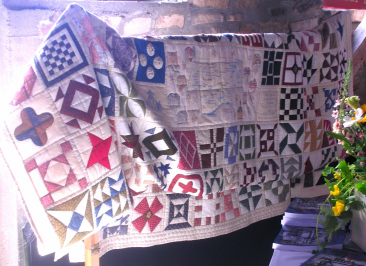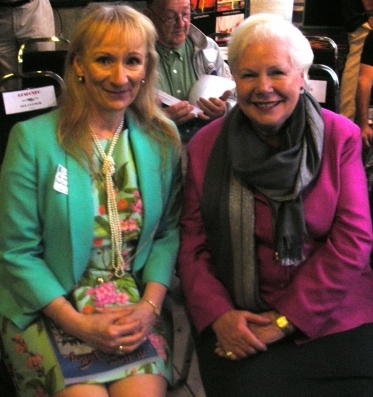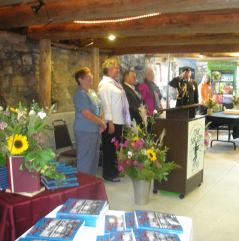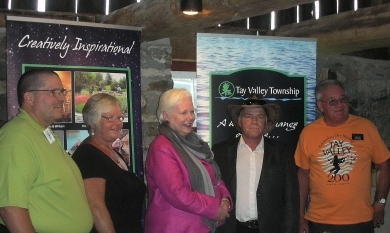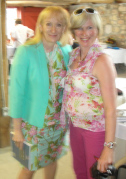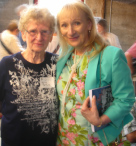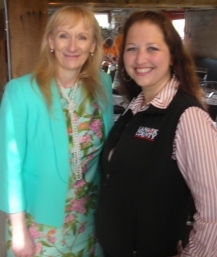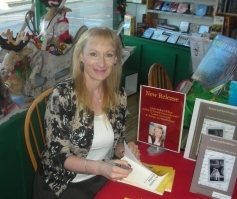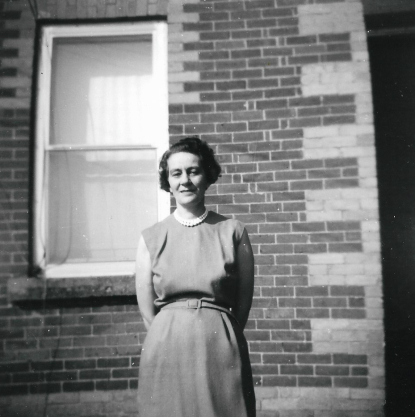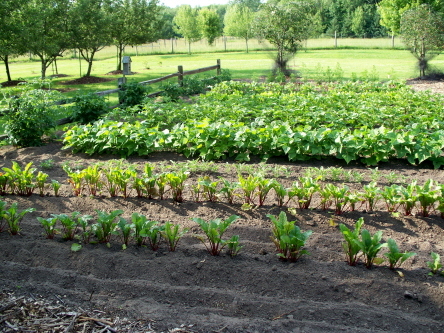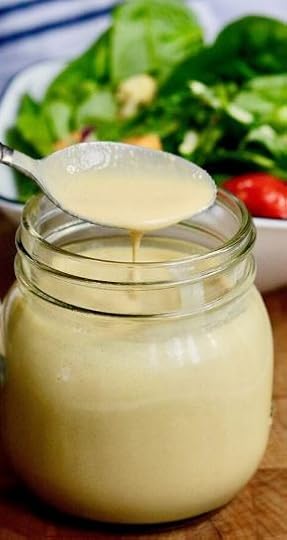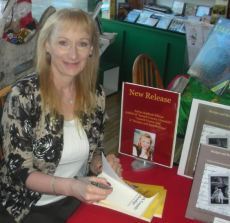Arlene Stafford-Wilson's Blog, page 29
September 5, 2022
Hometown Heroes 1982

In September of 1982, at the annual Perth Fair parade, three heroes emerged, going above and beyond, in what could have been an even greater tragedy.
Over 100 spectators were gathered on the corner of Halton Street and Gore Street, watching the parade on that Friday in September; the opening night of the 137th annual Perth Fair.
Two innocent bystanders, Amy Nighbor, age 4, of Smiths Falls, and Stephen Buchanan, age 7, were struck when a car plowed into the crowd. Seven others were injured, but not as seriously as the two children.
Ken Carson, age 30, jumped in front of the car which was pushing Amy, wedged under the front wheel in her stroller.

It was said that if it hadn’t been for the quick thinking, and fast actions of Mr. Carson, that the little girl, Amy, might not have survived.

September 8, 1982, p. 2, “The Perth Courier”
“It took a lot of courage to stand in front of that car!”, said Detective Sergeant Doug Cox, of the Perth Police.
A second hero, Stephen McPherson, age 28, an off-duty ambulance driver, was quick to assist Ken Carson in the quick transport of little Amy to the hospital.
Later, Amy Nighbor was transported to CHEO, the Children’s Hospital of Eastern Ontario, in Ottawa.
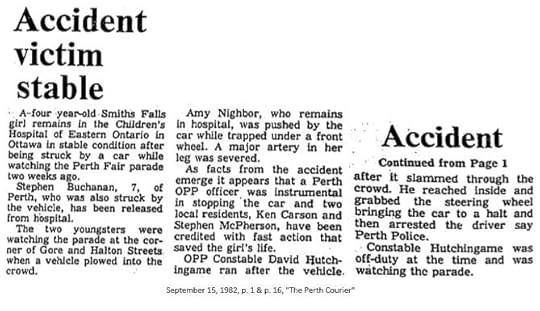
A third hero, off-duty officer, OPP Constable David Hutchingame chased after the car, after it slammed through the crowd, reached in, and grabbed the steering wheel.

September 29, 1982, p. 3, “The Perth Courier”
Certificates of Commendation
Ken Carson, Steven MacPherson, and Dave Hutchingame received Certificates of Commendation, issued by St. John’s Ambulance, for their heroic actions, at an awards ceremoney at the Perth Town Hall on February 19, 1983.

January 26, 1983, p. 24, “The Perth Courier”
These three men are Hometown Heroes, who went above and beyond, to help others in danger.
Many decades have passed since this tragic incident, and we might take a moment to pause and reflect on what could have been a very different outcome if these brave men had not been among the crowds on that fateful day in early September, 1982.
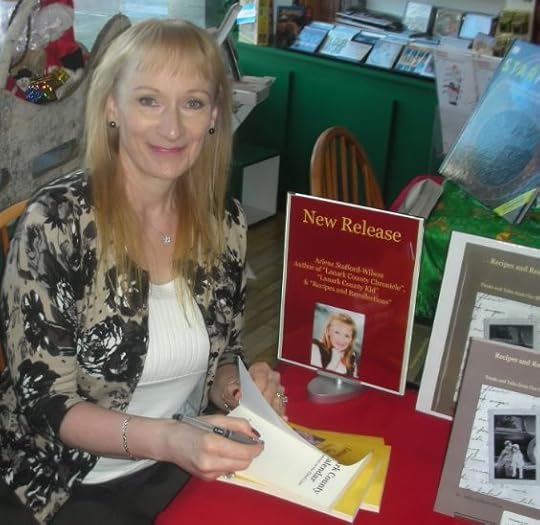
Arlene Stafford-Wilson
September 1, 2022
Memories of the Perth Fair
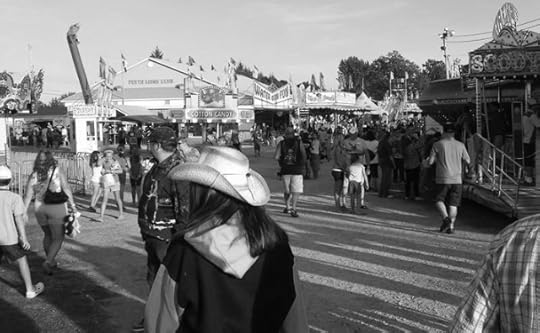
It wasn’t just our Mother who loved the Perth Fair. Yes, she spent months preparing for those brief few hours each Labour Day weekend, at the fairgrounds, along Rogers Road, but the rest of the family also felt a sense of excitement, rivalled only by Christmas morning!
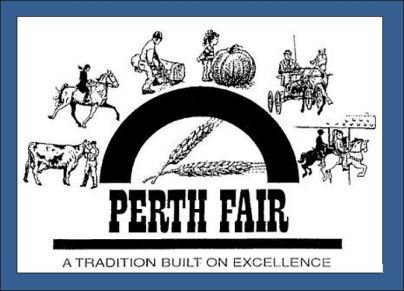
The day had arrived! The day that we would drive into Perth, park at our Aunt Pat and Uncle Peter Stafford’s house on Halton Street, walk up the road, and enter the gates. By the time we got to the entrance, and Mother showed her Exhibitor’s Pass, we were bursting with anticipation. I knew that Mother would be heading straight for the Homecraft Building to check on her entries, but instead, I chose to slow down, look around, and take it all in.
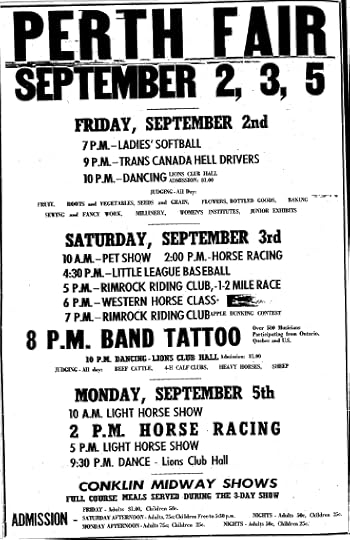
She glanced back, waved, and then rushed down the well worn path, through the midway, and up to the buildings. I stood with my back against the side of the Lion’s Hall, and glanced around. There was so much to see that I didn’t know where to look first. Being a kid, my eyes naturally gravitated toward the rides.
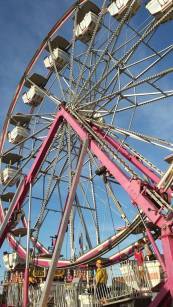
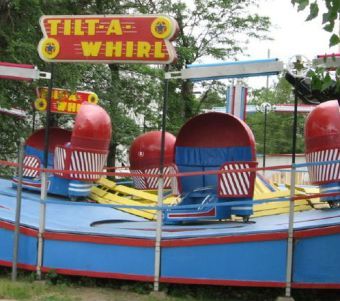
They were all spinning and whirring, and the bright sun was bouncing off of all of the shiny metal. There was a Ferris wheel, a Scrambler, a Tilt-a-Whirl, and the Bullet. The Swings took up a lot of room, and so they were set up to the right of the buildings. I could see four kiddy rides: a Merry-Go-Round, Baby Airplanes going round in a circle, Ladybugs, and a Little Red Caboose making its way along a tiny round track.
Once my eyes had taken in the rides, my senses turned to all of the sweet aromas of the Fair. Right across from where I was standing was the Lion’s Club ladies’ booth, and I could smell their fresh, homemade hamburgers, and the savory scent of fried sweet onions. Straight ahead of me, just past the entrance was a vendor swirling a paper funnel around and around, in a circle, pink cotton candy swelling out from the stick, as he twirled it inside the machine.
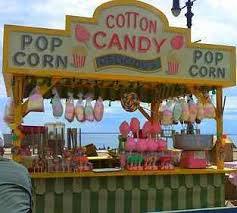
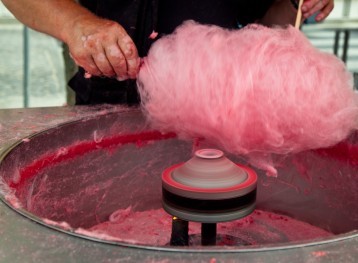
Next to the cotton candy stand, was a man selling corn on the cob, and several people were waiting in line. Folks were holding their cobs by a short wooden stick that had been plunged right into the big end of the cob, and there were two or three separate unwrapped pounds of butter set on the edge of the counter of the vending cart. The butter had already taken on a curved shape as people spun their cobs, and then salted them.
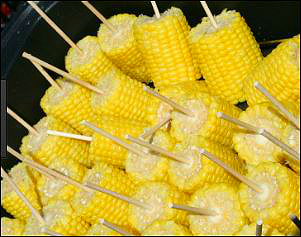

Next to the corn vendor was the hot dog cart. A tall, lanky man was grilling hot dogs on one side, and the finished dogs were spinning slowly around glistening on the grill. On the other side of the wagon, a younger lad was piercing hot dogs with long slender sticks, dipping them in batter, and placing them into a big deep fryer. The cart had a low shelf with mustard, ketchup and relish and some diced onions for people to dress their hot dogs.
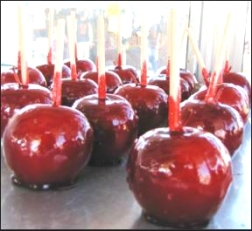
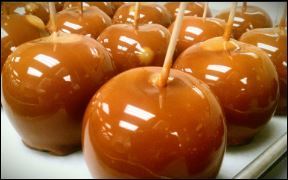
There were two more food carts, so I strolled a bit farther down the midway toward the buildings. The first cart held a popcorn machine, even bigger than the one that I’d seen at the Soper Theatre in Smiths Falls. It was a large, metal machine, painted red, and the popcorn was spilling out of the top into a big glass case. The vendor was lifting it out with a bright, silver scoop, and placing it into small white paper bags that were decorated with red stripes and a clown’s face.
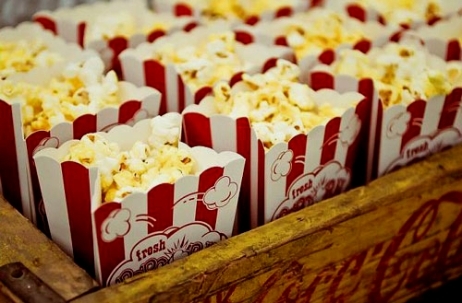
The last food vendor in front of the Commerce building, was making snow cones. There was a square, metal and glass machine and an old man in a dirty apron was pouring ice cubes into a big funnel on the top. There were white cone-shaped paper cups stacked in a tall dispenser attached to the side of the machine and when he cranked the handle on the opposite side snow came out of an opening at the front. There were clear plastic squeeze bottles lined up on a shelf, at the front of the machine, and each was labeled with a different flavour: cherry, orange, lemon-lime, grape and blueberry.
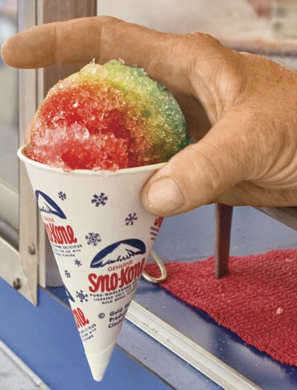
I’m not sure if I was really hungry or if it was just from seeing and smelling all of the different kinds of food, and I thought that I might buy either a small bag of popcorn, or a blueberry snow cone. I dug deep into my pocket, and pulled out my money. I had exactly twelve dollars, and my money had to last for the whole weekend, and this was just the first day. I needed to save some, because my friends Susan and Jane Munro, Patti Jordan, and Debbie Majaury, would be coming into town later, and I’d want to go on the rides with them. Because the rides were $1.25 each I had to be careful not to spend money on food, so I stuffed the bills and change back in my pocket, and kept walking, taking in all the sights along the way.
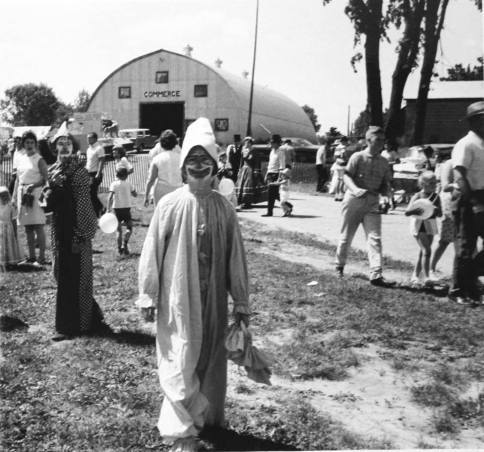
I heard a man’s voice yelling at me, and it startled me so much that I jumped. I looked toward the man timidly, and he was in a game booth, right behind a food cart, and he had a table set up with some wooden milk bottles, stacked in a pyramid. He had a baseball in his hand, and called to me to come and knock over the milk bottles. It scared me so much that I just walked away. I wasn’t used to strangers. We knew everyone out on the Third Line, and lots of the folks in Perth as well. None of the people we knew ever yelled at us like that, right out of the blue, and certainly not a stranger. I walked quickly away, not looking back.
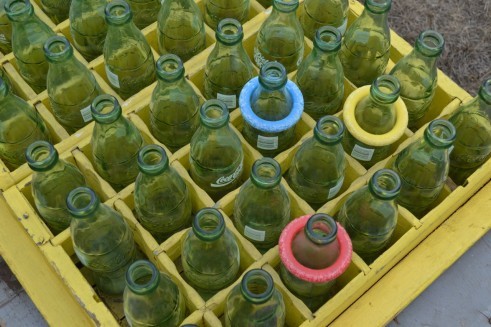
The people that operated the games made me nervous. They had a lot of tattoos, which was something we never saw in those days. Many of them were a bit too aggressive. I’d played some of those games before, and although I won, I didn’t get the big stuffed bears and dogs that were hanging along the top and sides of their booth.
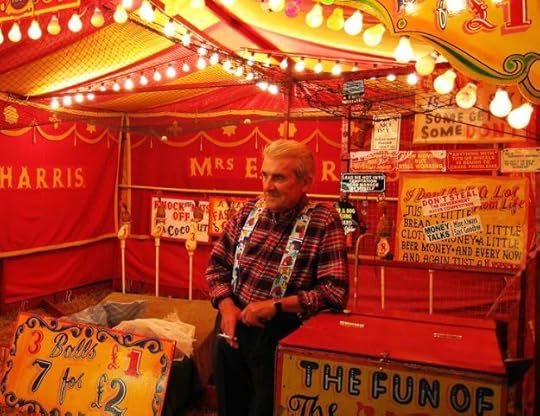
I’ll never forget the first time I played a game. The back wall of the booth had four or five rows of balloons blown up, and they were stuck to the wall. I thought I’d have no problem hitting one of the balloons, so when the man yelled at me to come and play, I thought it would be a sure thing.
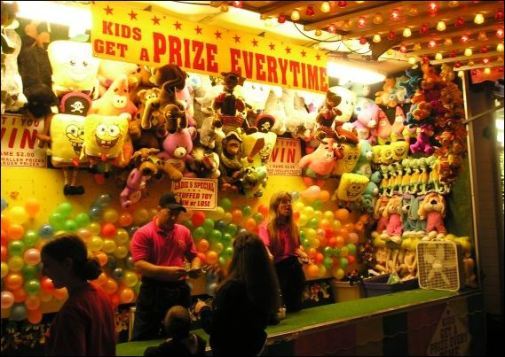
He said it was $1.00 for three darts so I handed him my money, and he handed me three darts. Sure enough, the balloons weren’t that far away, and I hit and burst all three of them.
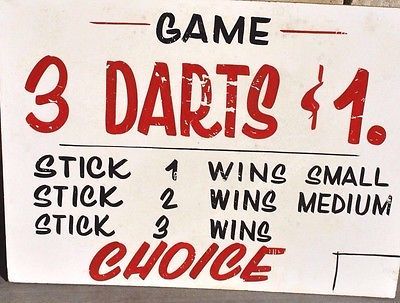
He reached down under the table, into a big cardboard box, and handed me a mangy looking stuffed snake. It was about six inches long, and had an orange felt tongue, badly stitched onto its mouth, and two black felt eyes, that weren’t even lined up.
I looked up at the big stuffed bears and asked him why I hadn’t won one of those. He said that my prize was a ‘small’ and if I wanted a ‘large’ prize I’d have to play and win, trading up to a ‘medium’ then win a certain number of ‘mediums’ and then I’d finally get one of the big bears. Holy cow! Talk about disappointed! What kind of scam was that? Folks from Bathurst Township were used to other people dealing with them fairly. This game seemed like out and out trickery, and I wasn’t very impressed. Still, I didn’t want to tell Mother that I’d just wasted my money, so I kept it to myself. I didn’t even want to tell my friends that I’d been fooled like that. I just felt stupid.
I walked by all of the other game booths, and watched people play. Some folks walking around the fairgrounds were actually carrying one of the great big stuffed animals. I wondered to myself how many of those mangy stuffed snakes they’d had to trade up in order to finally claim the big prize.

I walked past the last game in the midway, and there was a rough-looking older woman, holding a bunch of short, wooden fishing rods, with small black metal squares on the ends. There was a round aluminum tub of water on the ground, and floating along the surface of the water were dozens of little yellow plastic ducks, and they each had ‘S’, ‘M’ or ‘L’, marked on their heads in black marker – small, medium and large I guessed. I must have been staring too long at the tub of ducks because she called out at me to come and play. She said everyone is a winner. Not to be tricked again, I asked her what the prizes were, and she showed me. She didn’t have huge stuffed animals, but it was only fifty cents to play, and you could fish in the tub until you caught a duck.
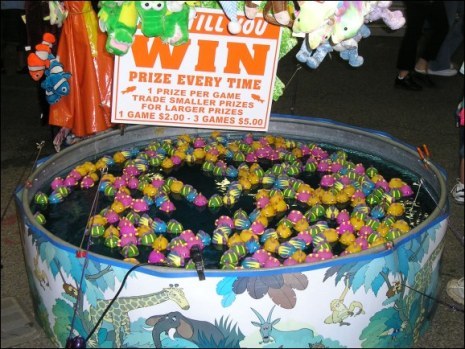
I dug into my pocket, and pulled out two quarters, gave them to her, and she handed me a fishing rod. By this time, after watching other folks play for a few minutes, I had figured out that the heavy black square on the end of the rod was a magnet, and that each of the yellow plastic ducks must have a magnet inside so they would stick to the line. I looked down into the tub, and I could see that there were about forty or fifty ducks marked with an ‘S’, maybe ten marked with a ‘M’ and there were only three that I could see marked with an ‘L’. I took my time, and positioned my rod right over one of the ‘L’ ducks and plunged it into the water. Wouldn’t you know it, just my luck, the magnet had stuck to a duck with an ‘S’, the lady pulled it out of the tub, and handed me a prize. It was a 45 rpm record in a paper sleeve. I thanked her, and looked at the label. It was the Shirelles’ song “Will You Still Love Me Tomorrow” Hmmm. Well, the record was a few years old, but we had a record player at home, and some plastic adapters to play 45s, so this didn’t seem like such a bad prize after all. Not bad for fifty cents!
The late August sun was working its way up into the sky, and I thought it must be close to noon. I was starting to feel hot, and decided to head up to the buildings, and cool off inside. The exhibit halls at the Perth Fair were grey metal arched buildings, with straight walls, and rounded roofs. One of the buildings was known as the Commerce building, and it had lots of different vendors selling their products and services. The other building was the Homemaking building, and this is where you could find exhibits of sewing and fancy work, vegetables, flowers, canned goods, maple products, and of course home baking. It’s also where you could find our Mother!
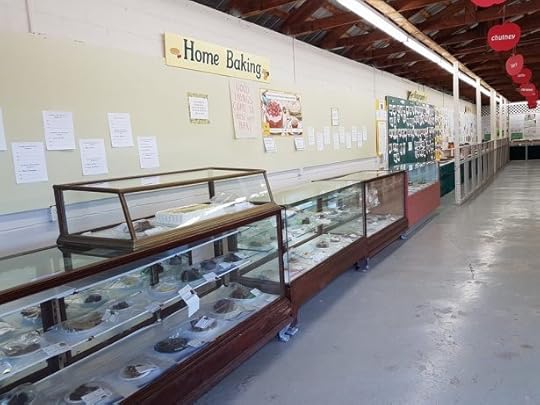
As I walked closer to the building, there were two tables set up, right outside of the entrance. One person was raffling off a quilt made by Mrs. Bert Frizzell, and the other was selling tickets for the annual draw to win a baby beef. Sure enough, as I approached the main door, I spotted Mother, standing along one of the baking counters, talking to Evelyn Bothwell, and Margaret Campbell. Mrs. Willard Shaw and Mrs. Archie Ferguson were working at the next counter, arranging some of the craft displays. The ladies all nodded and smiled at me, knowing that I was one of Mother’s ‘helpers’, responsible for carrying her baking in to the building each year, the evening before the judging took place. I usually had a meringue pie on my lap, in the car, on the way into Perth, and there were countless trays of muffins, loaves, cakes, pies, cookies, bread, rolls and biscuits to carry, carefully, into the building each year. Along with all of those tasty treats, she would also enter photography, flowers, vegetables and sewing, but it was the home baking competition where her talents shone.

Mother spotted me, smiled excitedly, and waved me over to the counter. “Your Mother won the most points in the baking category again!” Mrs. Bothwell exclaimed, and the ladies pointed out all of the red ribbons and tags, behind the glass counter. Mother beamed, and said that Mrs. Bell from Balderson had come very close to beating her, and that she’d have to stay sharp for next year!


There were also many other folks who won prizes at the Fair that year as well. There was a gate prize each year, and the ticket number would be drawn, called out, and the winner received ten pounds of Balderson Cheese. Now who wouldn’t want that! They estimated that the crowd that year was around 15,000 and I’m not sure who won the gate prize, but someone went home that night with a big slab of the best cheese in the county.

One of the most popular events was the harness racing, and the winner was Eddie Norris of Perth. There was also a Tractor Rodeo – contestants had to drive tractors through an obstacle course pulling wagons and manure spreaders. In the 14-18 yrs. division some of our local lads had a good showing. Bill Poole came 1st, Allan Lowry was 2nd, and Brian Miller of Drummond Centre came 3rd. In the 19 yrs. and over division Mervin Conboy of Maberly took first place, with Jack James from Middleville taking 2nd, and our neighbour from the Third Line, Wayne Conboy taking 3rd.
Donald Hossie, another neighbour, was the top winner in the seed and grain competition, and Mrs. Robert Moodie won the Sewing and Fancy work class with no less than 23 firsts! Mrs. John Auchterlonie, also from the Third Line, took top honours for her vegetables and fruits, and Mrs. Isobel Kent came first in the Flower competition.
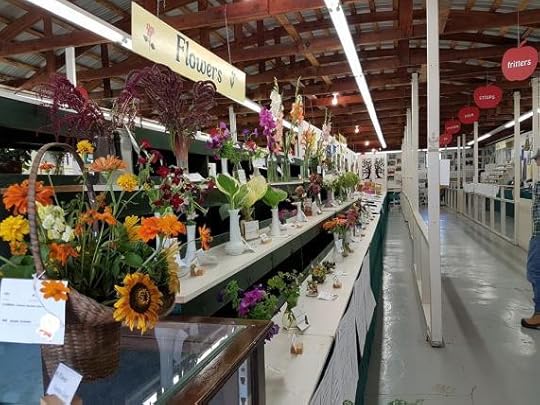
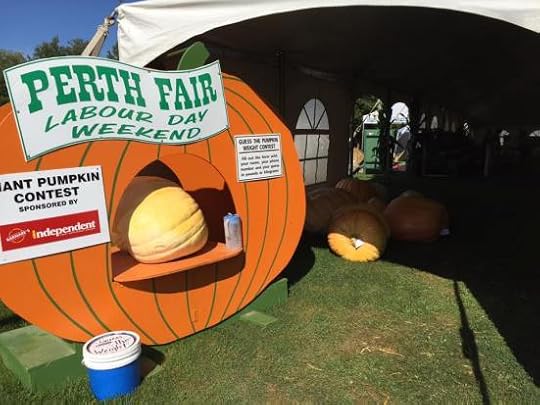
Ray Poole was the winner of the best bale of first cut hay, and our neighbour, John Miller of Glen Tay, won for the best dairy cattle. John’s sister Ruth Miller, won for the best senior calf. Other winners from the Third Line included Paul, Dale and Jane Brady, winners for their 4H dairy cattle entries. In some of the other 4H competitions local lads Alfred Bowes and Brian Miller, John Miller, and Linda Bell of Balderson were winners.
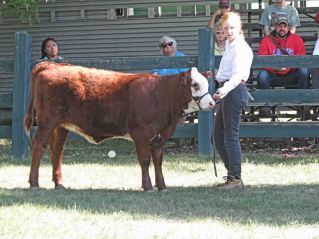
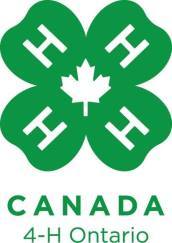
Everyone enjoyed the light and heavy Horse Shows and the livestock competitions. That was the first year that Charolais cattle were introduced into the mix, and so it was quite special to see them in the arena.
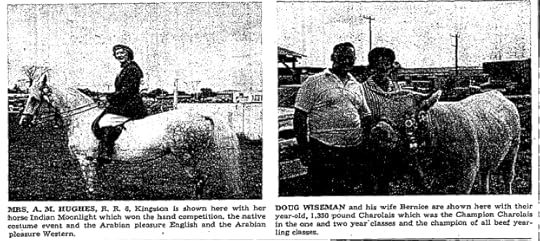
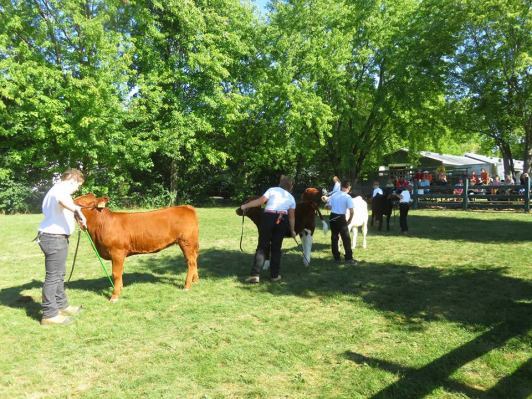
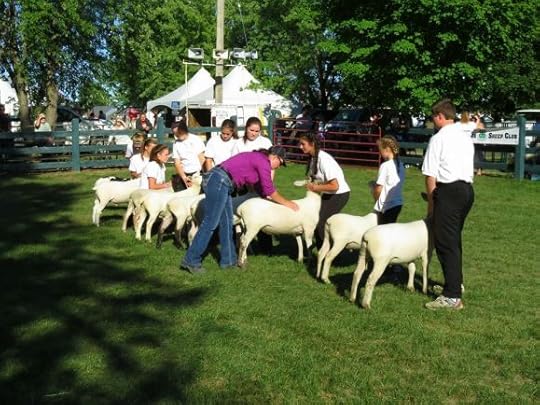
My good friends came to the fairgrounds that Saturday afternoon, and we had a wonderful time, riding the Scrambler, and the Tilt-a-Whirl, screaming, laughing, and then feeling dizzy on our walk back down the ramp, at the end of the ride. We were all a little nervous about riding The Bullet, because while one of the two cars was right side-up, the opposite car was up-side-down. We stood there quite a while watching other people riding, and screaming, and laughing, before we got up enough nerve to try it out ourselves. I didn’t really like being upside-down, and some of my change fell out of my pocket, onto the ground below. Luckily, one of our neighbours Linda Brady saw it fall, and she stood there and waited, until the ride was finished, and hung onto my change for me.
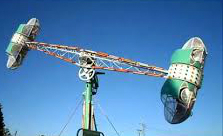
As always, the Grandstand shows at the Perth Fair were great entertainment for people of all ages! Beautiful late summer evenings, clear skies, all the rides lit up, the scents of delicious food in the air, and wonderful live music, made those nights magical!

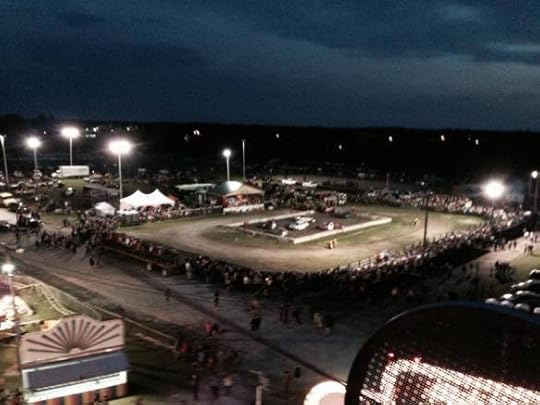
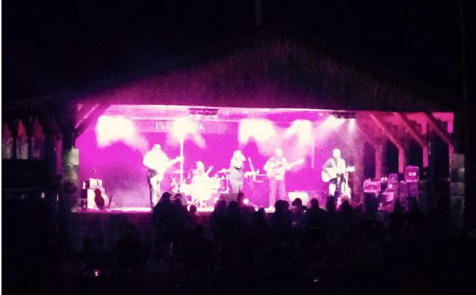
Everyone always came out to see the famous Trans Canada Hell Drivers!

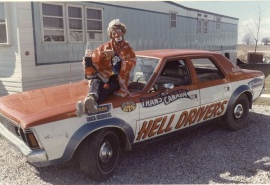
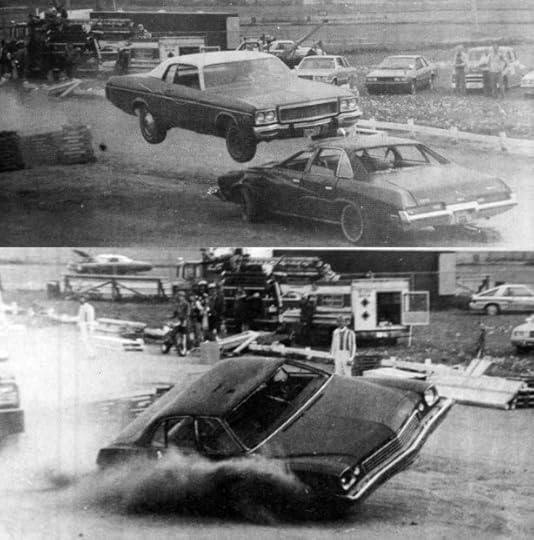
Along with the Grandstand entertainment, one of the highlights of the Fair that year, was the Old Time Fiddlers competition on Sunday, and the musically-gifted Dawson Girdwood walked away with the top prize. Barb Closs from Lanark came second in the step-dancing competition, although we thought she should have come first, she was such a talented performer. Watching the fiddling and step-dancing was a memorable finish to the Labour Day weekend.
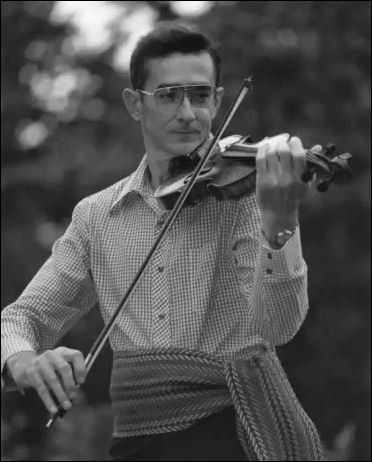
The last night of the Fair, as always, was bittersweet. We knew that it was almost over for another year. I walked through the midway one more time, all the way to the Lion’s Hall. The ladies in the Lioness Booth were packing up their big jars of mustard and relish, and some of the nearby vendors were starting to clean their food carts, and take them apart.
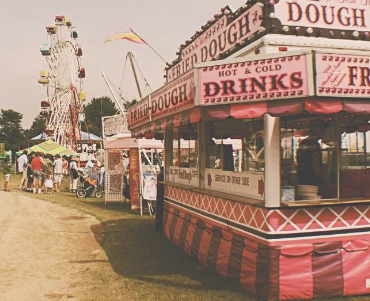
Some diehard fans of the Fair were still playing games; taking a last spin at the Crown and Anchor wheel, or throwing one last pitch at Skeet ball, not wanting the fun to end. Although it was getting late, there were still a handful of people on the rides laughing and screaming. The good-natured folks running the rides didn’t seem to mind and they gave these last few stragglers extra long rides.
As I walked back up through the midway, I took one last look behind me, as if I wanted to freeze the moment in my memory, then I reluctantly climbed into the car. Dad started up the engine, and drove through the side entrance, onto Cockburn Street.
It was a wonderful fair! I sat in the back seat of the car, tired from the busy weekend, as Mother chatted excitedly to Dad, already planning her exhibits for next year’s fair.
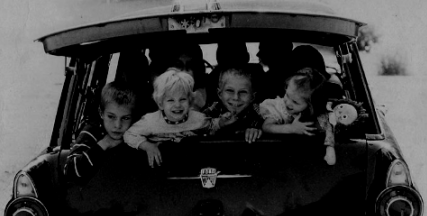
School would be starting soon, and the days would grow cooler, and the sun wouldn’t feel quite as strong as it did for the Fair. In the weeks to come we’d bring our jackets down from the attic, and spend our evenings doing homework, instead of riding our bikes up and down the Third Line. As the daylight hours dwindled down we’d begin to see the onset of nature’s paintbrush, and its random strokes of yellow and orange, dotted across the maple trees in our yard. This would be our last taste of summer for a long while, and what could possibly be a more fitting way to finish off the season, than a glorious sunny weekend spent at the Perth Fair!
…………
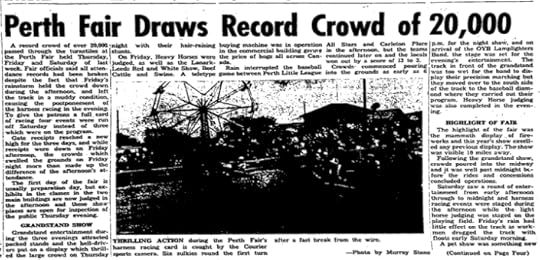
…………
This story is an excerpt from:
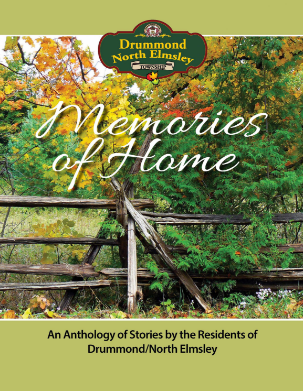
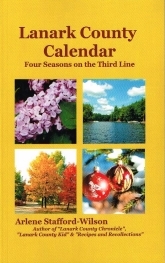
To order:
https://thebooknookperth.com/product/lanark-county-calendar-arlene-stafford-wilson/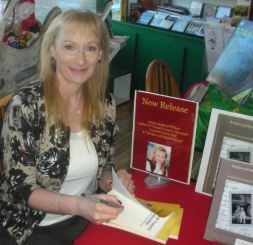
Arlene Stafford-Wilson
http://www.staffordwilson.comAugust 31, 2022
Ompah Stomp!

“Drivin’ country roads, highway 509,
August sun is shinin’, and we’re feelin’ fine,
Been workin’ real hard, and we need a little break,
Headin’ for the party up at Palmerston Lake
Grab a bottle, twist the cap, and pass it around,
Swayin’ with my baby to the country sounds,
Music’s loud, fool around, go for a romp,
This is how we do it at the Ompah Stomp”
Arlene Stafford-WilsonThe Ompah StompIt was late August, 1978, that we heard about a music festival, to be held over the Labour Day weekend, in Ompah. This was going to be a back-roads tour, to end all back-roads tours – an outdoor party with live music, and we couldn’t wait!
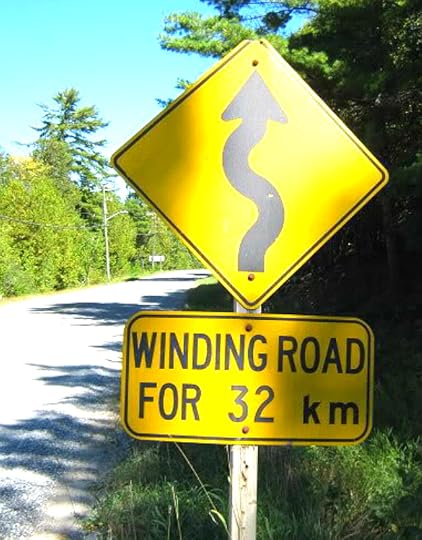
In those days, Ompah was a tiny, quiet, village. The most popular place in Ompah, was the Trout Lake Hotel, owned by Wayne Kearney.
The building was originally a private residence; over 150 years old, in fact it was the oldest building in Ompah. Over the years, the residence became a popular local bar. The old timers around there say that they began serving liquor there in 1904. It was the first licensed establishment in Eastern Ontario, and the locals also claimed that it was one of the first bars in the province.
The hotel was rumoured to have been the setting for some famous and infamous barroom brawls too, but we won’t get into that. The busiest times were in the summer. During the year, there were quiet times, but the seasonal visitors, mostly summer fishing enthusiasts, and the winter snowmobiling patrons, kept it fairly busy.
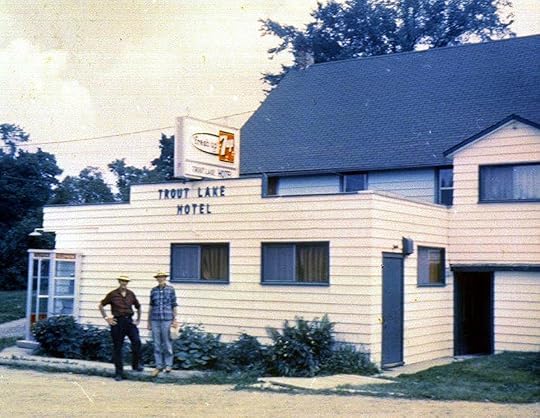
After much anticipation, Labour Day weekend, 1978, finally arrived.
We jammed as many young people that could fit, into one of my friend’s parent’s cars, and off we headed to Ompah. We drove up the Third Line, and turned onto Cameron Side Road, past Calvin Church, over the railroad tracks, and onto Hwy 7. We turned onto the Elphin Maberly Road, and continued onto Hwy 509, then Lake Road, and Lafolia Lane. We parked, and got out of the car. The Stomp grounds were beautiful, green, and lush, with tall, majestic trees, situated on a hill, overlooking scenic Palmerston Lake.

That first Ompah Stomp, was held on September 3, 1978, and their special guests were Max Keeping, of CJOH TV, and Doug Anderson of CKBY FM. There was a step dancing contest, held at about 8 p.m., followed by old fashioned round and square dancing. The musical guest artists that year were Sneezy Waters, Mike O’Reilly, and Wayne Rostad.
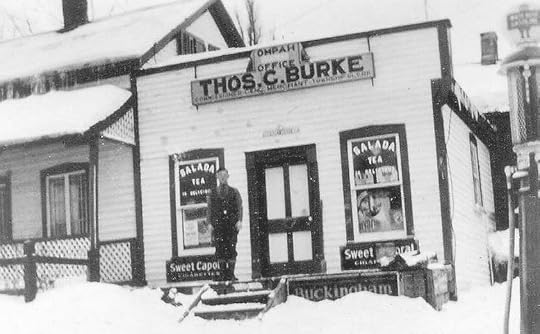

Over the years, we grew to believe, that this annual country music festival, was our own little ‘Woodstock’. The Ompah Stomp grew, in leaps and bounds, as people heard about it, and wanted to experience the live music, and party atmosphere.
That first year, in 1978, the organizers had anticipated about 200 people attending, and the total numbers were closer to 3,500. The second year, the crowds grew to 5,000 and the third year, saw the attendance numbers rise to 6,500.
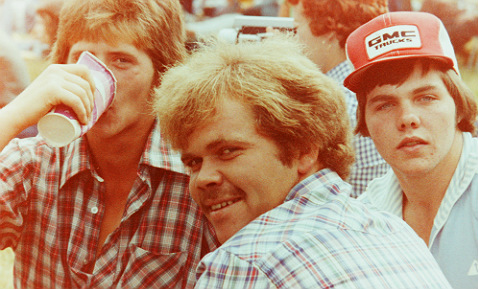


Some of the musical acts that performed at the Stomp were: Neville ‘Nev’ Wells, , the Family Brown, Jack McRae and the King of Clubs, The Prescott Brothers, Hugh Scott, Ron McMunn and Carbine, Steve Glenn, David Thompson, Fred Dixon, Lynn and Chris, Lloyd Wilson, Dallas Harms, Ted Daigle, C-Weed Band, Terry Carisse and many others.
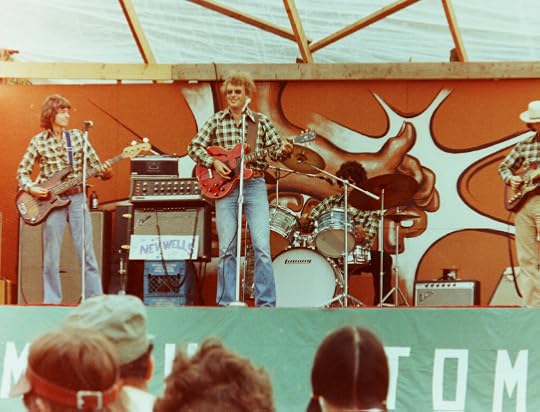
 Guitar: Neville Wells
Guitar: Neville Wells
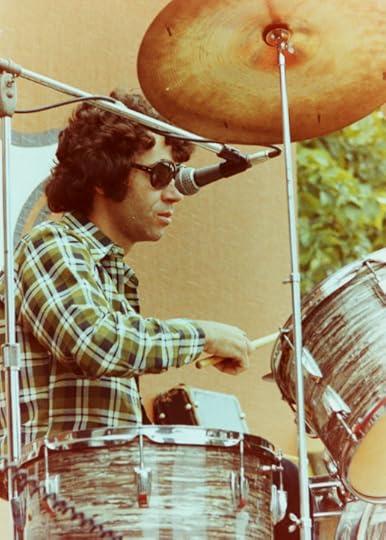
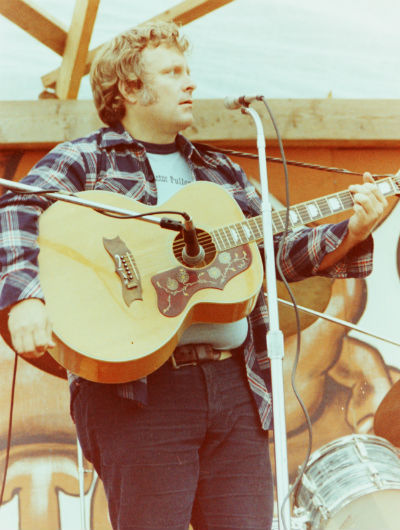
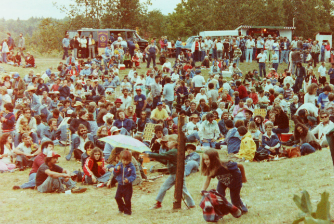
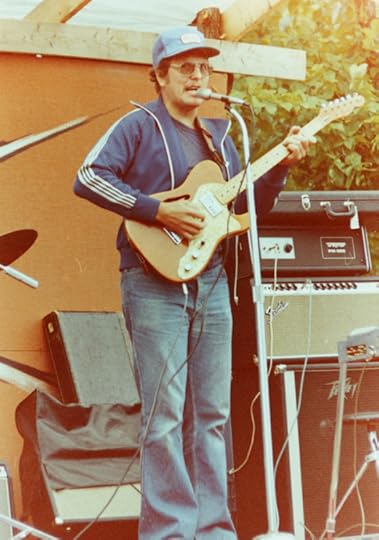


“Perth Courier” September 12, 1979 – a review of the second year of the ‘Stom p’:
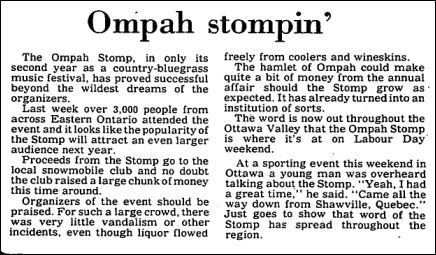
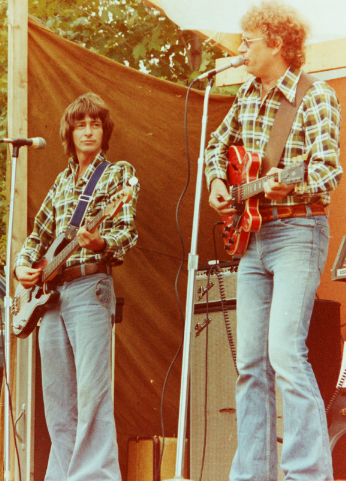

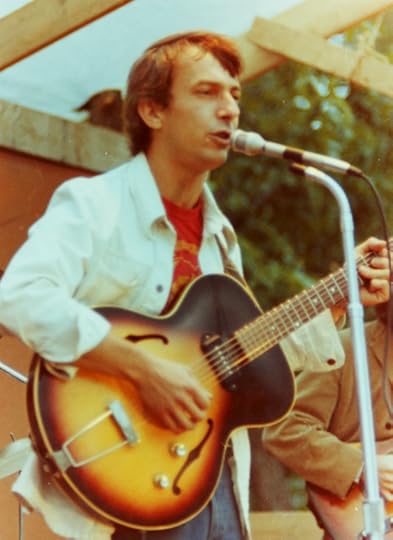 Sneezy WatersA poem written by Kathy Norwood, about the ‘Stomp’, printed in March 1980
Sneezy WatersA poem written by Kathy Norwood, about the ‘Stomp’, printed in March 1980

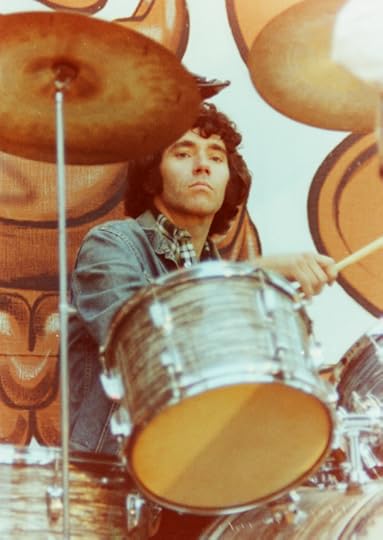
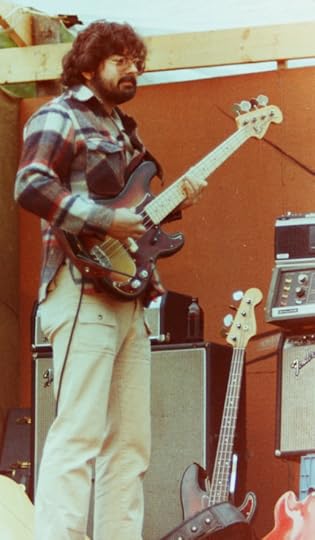
The Ompah Stomp became a much-anticipated annual event, and was featured in the local newspapers.
“Perth Courier” Sept. 2, 1981, page 19:

Poster from 1982
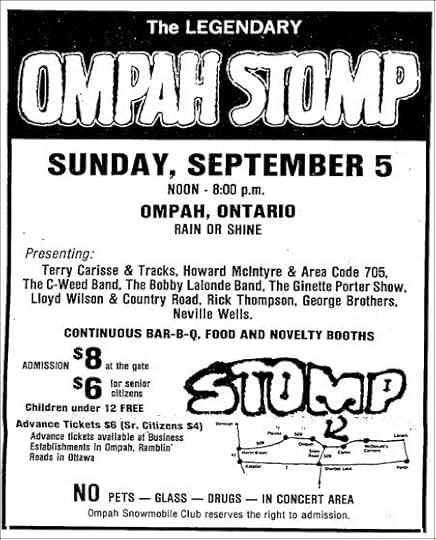
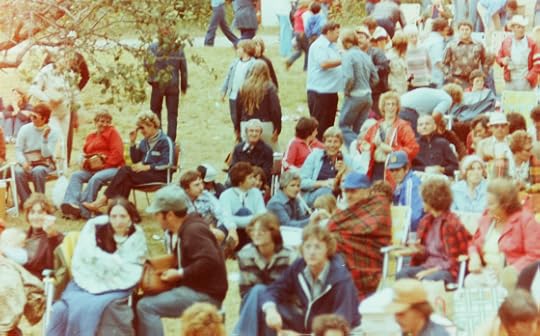
The Road to ‘The Stomp’ – 1983

Poster from 1984

Liquor and beer flowed freely from coolers and wine-skins, and the lineup at the washroom facilities was unbelievably long, but everyone enjoyed themselves just the same. It was wonderful to have a music festival so close to us. In those days, if we wanted to hear live music of that caliber, we’d have to travel to Ottawa or Kingston, so it was great to have the Ompah Stomp so nearby.

As the years passed by, the Ompah Stomp had a reputation as a wild party, and the local police adopted stricter controls for the festival.
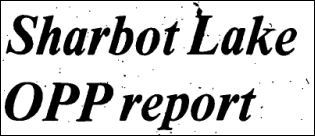
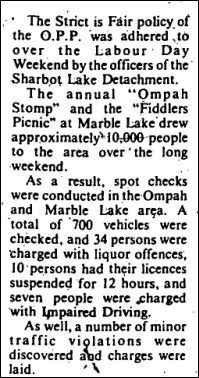
The Stomp carried on for many years, after those first few annual celebrations. Visitors traveled from the U.S., and from neighbouring provinces as well.
Labour Day weekend was one of the busiest and most exciting times for us, in the area, because of the Ompah Stomp.

Looking back, it’s difficult to imagine that a tiny village of around 100 people, and their local snowmobile club, could create a music festival, attracting thousands of people, from all around.
The Ompah Stomp was a shining example of the spirit of the people in rural Eastern Ontario, and what they could accomplish. They never faltered in their belief that they could succeed, or lacked the confidence to organize a music festival just because they were a handful of folks, from a tiny village.
The Ompah Stomp became a metaphor, an example for all of us, that it only takes a few people who believe strongly in something to make a difference. It sure made a difference for us kids in the country, who were always looking for a little excitement.
I will always remember those special times at the Ompah Stomp, and how they made our last weekend each summer something we’d all remember fondly for years to come.
…
Photos from the 1978 Ompah Stomp from the private collection of Don White, from the band, Grateful We’re Not Dead: Grateful We’re Not Dead Facebook Page
Many thanks to Don White and Neville Wells for providing the names of the musicians in the photos!
Neville Wells, a founding father of the ‘Ompah Stomp’, was inducted into the Ottawa Valley County Music Hall of Fame, in 1994.

For more information on Grateful We’re Not Dead: Grateful We’re Not Dead Official Band Website
……..
Some of the families who settled around Ompah: Dunham, Kelford, Closs, Conlon, Dawson, Ellenberger, Elliott, English, Gunner, Hitchcock, Cox, Keller, Killlingbeck, Kirkwood, Mabo, Massey, McGonigal, McDougall, Molyneaux, Moore, McDonald, Murphy, Payne, Praskey, Sproule, Thomas, Tooley, Richardson, Riddell, Roberts, Sproule, Stewart, Stinson, Thomas, Uens, Ostler, MacRow, Martelock, James, Ackerman, Allen, Struthers, Brown, Gunsinger, Lemke, Armstrong, Jeannerett, Hermer, McNeil, Badour, Johnston, Kring, HIll, Weiss, Wood, Card, Boyd, Dempster, Donaldson, Larock, Morrow, Mundell, Praskey, Ryder, Shanks.
… Search for your ancestor in the 1901 Census of Canada:
…
Why Did the Ompah Stomp end? Find out the real reasons behind the final days of the Ompah Stomp, from the people who were there…Discover the ‘glory days’ of the Ompah Stomp, how it began, who was there, the unforgettable parties, the music, and more:
“The Legendary Ompah Stomp”, in the book –
‘Lanark County Calling: All Roads Lead Home’ ISBN: 978-0-9877026-61
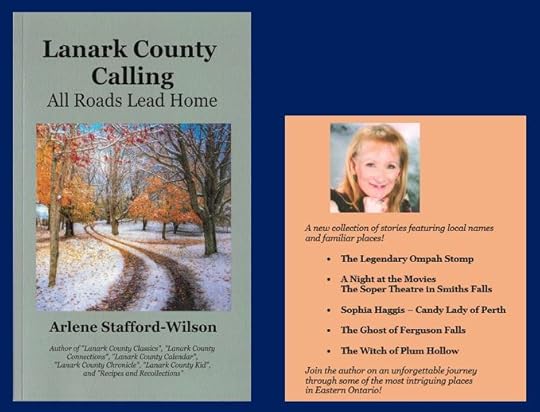
Available at The Book Nook and Other Treasures, and Spark Books, in Perth, Mill Street Books in Almonte, or online at http://www.staffordwilson.com
For more information on the history of Ompah and some of its founding families:
Clarendon and Miller Community Archives:
http://www.clarmillarchives.ca/index.html
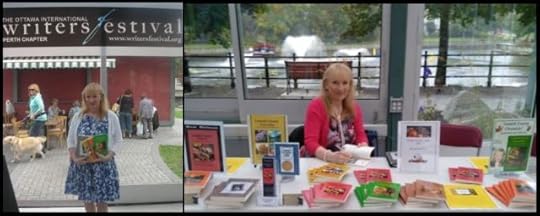
Arlene Stafford-Wilson
August 27, 2022
Our Look Back – Perth Fair 2012!
What is it about a country fair that draws us in through its gates, again and again, with sights and sounds so familiar, and yet, the excitement and anticipation as fresh as our very first visit?
Is it the once-a-year scents of the cotton candy, the candy floss, and the Tiny Tom donuts drifting through the air along those well-worn paths?
Some enjoy the competition, and they may prepare all year to challenge others with their baking skills, their success in growing vegetables and flowers, or their excellence in raising livestock and field crops.
Maybe it’s the unforgettable magic as night falls on the hot late-summer day, to the bright lights and sounds of the midway.
For some, it might be a visit to the commercial buildings, to check out the vendors, and discover some new gadgets or old favourites that we’ve grown to love over the years.
In 2012 we had a booth, set between a talented wood carver from Killaloe, and a girl named Josie, selling Watkins products.
Many old friends and neighbours dropped by to say hello: Art Perkins, our former next-door neighbour, Mavis (Jordan) Wollam, and her husband Rod, Lyle and June Conroy – Lyle, a long-time member of the Fair Board and June – who worked with Mother as a fair Judge in Homecraft for many years. It was great to see so many faces from the Third Line – Janice (Jordan) Gordon and husband Randy Gordon, Elaine Morrow, Sylvia ‘Sib’ Turnbull, Trina and Sawyer, Wayne and Margery Conboy, and Susan Couch, along with newlyweds, Diana Conboy, and her husband. It was a delight to chat with Wanda Murphy and her two beautiful daughters – who grew up in our former home on the Third Line. A cousin, Peter Stafford, also stopped by to say ‘Hello’.
Margery Conboy was Winner of ‘Most Points in Baking’ in 2012! Her tarts, cakes, many pies, cookies – all looked very tempting displayed in the Home Baking section of the Homecraft Building.
As the day wound down and the sun set we were treated to the sounds of Pembroke native, country artist Jason Blaine, among the dazzling lights of the midway and shrieks of excitement rom the rides.
So, what keeps the crowds coming back again and again to the local fairs? Perhaps it’s a longing to return to a more innocent time, when the world was a simple place, more predictable, and when there was a sense of pride in old traditions.
Maybe it’s a place where time stands still, and we can rediscover the young child who lives within us. As we step through those familiar gates each year, it’s our portal to the past, a trip back in time, a journey back to innocence and youth. Perhaps that yearly time-travel we embark on is the best midway ride of all.

Arlene Stafford-Wilson
August 25, 2022
Late August at the Train Tracks
“Summer was now in the full glow and luxuriance of its richness”
Charles Dickens

Considering the amount of time we spent playing at the train tracks near the 4th Line, it’s a miracle that none of us was ever hurt. Sometimes we’d take giant steps on the railway ties, spaced a little too close for a normal stride, all the while surrounding ourselves with that distinct scent of linseed oil used to preserve them. I preferred to walk on the shiny steel rails and test my balance, although the laws of gravity often won that battle, and I’d fall, stumbling onto the coarse gravel below. Although our parents never told us not to play on the tracks, I imagine they were counting on the fact that we’d have enough common sense to head for the ditch if we saw the green signal light come on, or heard the whistle off in the distance. None of us had any intention of playing chicken with a train.

Train Tracks – Perkins’ Side Road, Tay Valley Township
My brother, Roger, and I, visited the train tracks often, and in a summer ritual that went on for years, we’d each place a penny on the rails, and then sit back under a tree near the tracks, and wait for the train. Two country kids, with no particular plans for the day, and no knowledge of the train schedule, content to sit and wait, for as long as it took, to get our prize, of two flattened pennies. We had no idea at the time that we were learning an important skill that would come in handy later in life, called patience.
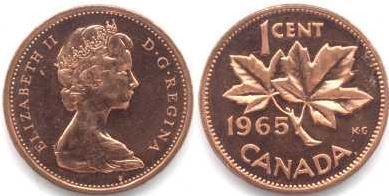 [image error]
[image error]
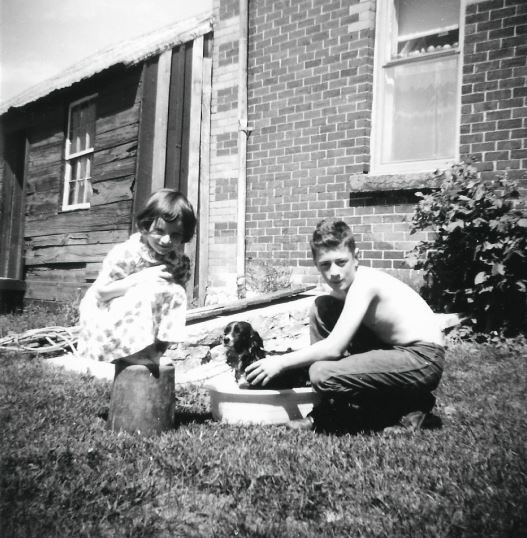
Arlene Stafford-Wilson and Roger Stafford, giving a bath to Mike, the family pet, at the Stafford house

The gentle slope under the tree near the tracks, where we sat and waited for the train
It’s sad to say, but kids today couldn’t duplicate this little pastime of ours even if they wanted to. There aren’t many pennies to be found these days, and even fewer kids without a mobile phone which they’d likely use to check the train schedules, removing altogether the element of surprise. After sitting under that tree for what often seemed like hours we were so excited to finally see a train come barreling down the tracks. Once the train had passed by, we’d climb down from our perch, and scramble around to find our pennies sometimes scattered in the gravel, or in the grass nearby, and never on the rails where we’d left them.
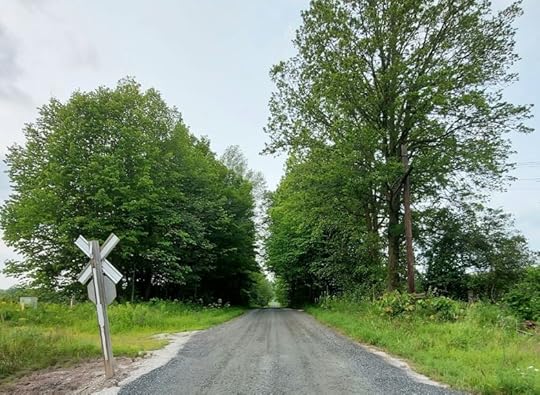
I always thought late August was the prettiest time to sit by the tracks, surrounded by the Black-Eyed-Susans, the willowy hay, and the milkweeds. There was something magical about the soft sweet scents of late summer, when the leaves overhead were their greenest, the vibrant wildflowers were at their peak, and the boisterous heatbugs buzzed and sang their songs of the season. The sun streamed down like a warm hug from above, beckoning us to play another game, wander farther down the dusty side road, and dream another dream, on those blissful childhood summer days.


Arlene Stafford-Wilson
August 18, 2022
Genealogy Tip: Record and Share Family Stories
We each have our own recollections of past events, our personal memories of family members, and these are the building blocks for creating and recording our own stories to preserve in our family histories.
I would like to share some tips and tricks for a successful and memorable interview with family members, and how to gather those special family stories that make each of our individual histories so unique.
Family stories help to round out the dates and facts in a family genealogy. A good genealogist will be able to tell you the birth, marriage and death dates for a given ancestor, but a wonderful way to enrich those necessary facts is a family story.
The story may be an account of a family event such as a special anniversary or occasion or may just be a simple recollection of the family member’s childhood, or their days at school.
School DaysWhen interviewing an older relative ask about their teachers, the name of their school(s), and ask them to recall the names of their classmates.

Your family members who served in the military may have some fascinating stories to share of their days in service and historical events that they may have witnessed. These are the stories that enhance and personalize our genealogical dates and documents.
Do you have a family member who served in the war? Ask them to tell you some of their stories and the places that they may have travelled to. What do they recall about the war years? What were the highlights of their days in the military?
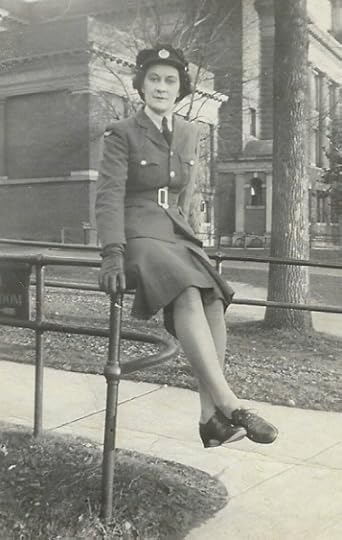
The holiday season is just around the corner and it will be a time when extended families get together to celebrate Christmas and the New Year. Let these occasions be your opportunity to record some of your family stories by conducting interviews with your relatives.

• Who are your oldest family members? Begin with them.
• Will it be formal or informal?
• One on one, or a group?
• A group will give many different perspectives on the same subject
• Pen and paper
• Camera / video camera
• a device to record audio
• Bring ‘memory-joggers’ – old photos
• Bring old news clippings
• What local, national or world events happened during their lifetimes?
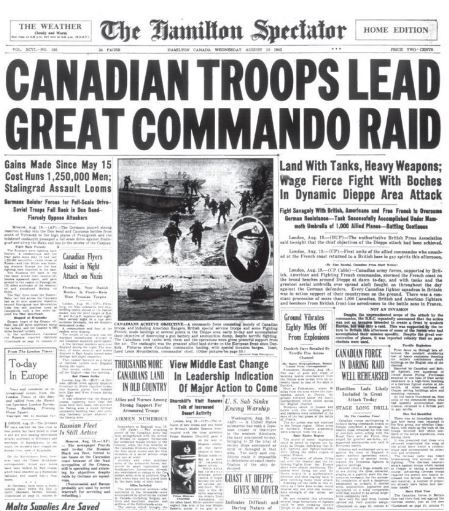
• Ask for permission to record/film
• Let them know what you are planning to do with the information
• Are there times during the day when older relatives are more alert?
• Take regular breaks
• Every family has them
• Be sensitive about family skeletons
• Move on if a topic makes your relatives uncomfortable
• You may learn something new
• Make sure that you have permission to share the story
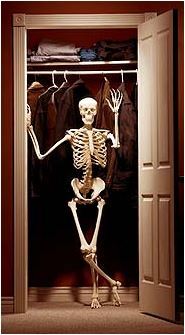
A Successful Family Interview
• Have a list of questions prepared but don’t follow it exactly, let the ideas flow
• If your relative is telling a story let them lead the conversation
• Let your relatives share their memories
• Ask if you can follow up with additional questions after the interview
After the Interview
• If you have taken photos or made an audio recording – make copies
• Don’t store the copies in one place. Share one with a relative in case the original is lost.
• While your memory is fresh extract the information and add it to your family tree
• Send a thank-you note and a copy of the updated family history
Get Organized!
In closing – a little organization before and during the interview will help to ensure a successful and enjoyable time for both yourself and your relative.
Remember – What the next generation will value most is not what we owned, but the stories of who we were and the tales of how we lived!

………………..
Arlene Stafford-Wilson
Photos:
1896 photo: from the family collection. My grandfather – Michael ‘Vincent’ Stafford seated on the floor, and my Great-grandfather Thomas Stafford with the white beard, seated across from my Great-grandmother Mary (Carroll) Stafford. Thomas was the youngest son of pioneer settler Tobias Stafford who came from Kilanerin, County Wexford, Ireland and settled on the 11th concession of Drummond Township in 1816. Mary Carroll’s father Patrick Carroll came from County Limerick, Ireland and was killed by a falling tree at age 34. He is buried in Mt. St. Patrick cemetery, Renfrew County.…………
S.S. 4 Bathurst 1964 softball champions – FRONT ROW David Scott and Bill Cavanagh MIDDLE ROW Earl Conboy and Ronnie Brown BACK ROW; Arthur Perkins, Roger Stafford Norman Kerr Arnold Perkins Connie Conboy and Mrs Mary Jordan……….
photo of Corporal Audry (Rutherford) Stafford, R.C.A.F. WD, taken in 1943, near her parents’ home in Edmonton, Alberta.August 10, 2022
An Afternoon to Remember – Tay Valley Township’s 200th Anniversary Launch
The overcast skies and threats of rain didn’t dampen the spirits of the enthusiastic crowds that packed the Eco-Tay Centre on Saturday afternoon to mark the launch of Tay Valley’s 200th anniversary celebrations in the late summer of 2016.
The well- organized event ran like clock-work, beginning with the volunteers warmly greeting visitors at the gate, accompanied by the well-designed, colourful signage proclaiming that this was ‘the place to be’ to celebrate the history of Tay Valley Township.
The event was held in an enormous rustic barn, one of the many lovely buildings on the property known as the Eco-Tay Education Centre. The Eco-Tay Centre, owned by Michael Glover and Annie Dalton is the site of the Ritchie family homestead, the original settlers in 1816.
The barn was a hive of activity, with something for current and former residents and history-lovers of all kinds. Kay Rogers, Editor of ‘At Home in Tay Valley’ was busy at the book table, signing copies of the popular book, while visitors waited in line, eager to purchase the historical publication.
Over 60 of the contributors – writers, artists, videographers and story-tellers were present at the event, and the room was abuzz with lively conversations and reminiscences of days gone by.
Kay Rogers, Editor, “At Home in Tay Valley”A beautiful cake, artfully decorated with the Tay Valley 200th anniversary logo was the centerpiece for a table covered with delightful goodies to please the most discerning palate.
Tay Valley Township 200th Anniversary CakeNot far from the book table, positioned near a doorway, and back-lit by the sun, was perhaps one of the loveliest quilts imaginable, displayed with pride, created and stitched by the Lanark County Quilters Guild. This awe-inspiring quilt features 200 quilt squares, and an actual map of the original 1816 settlements. The 200-square quilt was fashioned specifically for the 200th anniversary celebrations, and showcases the fine work done by the members of the Guild.
A special announcement was made around 2:00 pm that the guest of honour would be arriving shortly. Entering the building with a military escort, the Honorable Elizabeth Dowdeswell, Lieutenant Governor of Ontario, representing Her Majesty Queen Elizabeth II in Canada, was welcomed by all present.
Honourable Elizabeth Dowdeswell is the 29th Lieutenant Governor of OntarioThe opening ceremonies were led by Lanark County Warden, and Reeve for Tay Valley Township Keith Kerr, officially declaring the launch of the 200th anniversary celebrations.
Her Honour, Elizabeth Dowdeswell graciously thanked Tay Valley Township for inviting her to participate, and she shared some inspirational thoughts on the importance of preserving local history for future generations. Kay Rogers shared her experiences of editing the 200th anniversary publication, comparing it to an old fashioned ‘bee’, where many hands make light work.
It was a pleasure to meet with the distinguished guests, as well as some familiar faces from the neighbourhood – Maxine and Keith Jordan, Verna Perkins, Dianne Tysick Pinder-Moss, Nancy (Miller) Chenier, and Beverly (Miller) Ferlatte.
It was lovely to have the opportunity to meet Eco-Tay owner Michael Glover, and Lanark County Tourism Manager Marie White.
Marie White, Lanark County Tourism ManagerThe Lieutenant Governor, along with County Warden Keith Kerr toured the grounds of the Eco Tay property, and exchanged thoughts on the 200th anniversary plans in place for 2016, and the highlights of events taking place in the months to come.
Walking the grounds of the beautifully maintained property, and the lush green landscape stretching in every direction, it was a time to remember and reflect on the original owners, the Ritchie family, who in 1816 cleared the land, built a home, and started their lives in the new world. It was a day to remember all of the original settlers to Tay Valley, and how they laid the foundations for our communities and our futures.
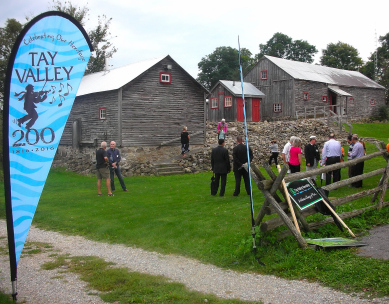 This special occasion was a time to reflect on those that came before us, and a day to celebrate the achievements of the past 200 years. Many thanks, to the organizers and the volunteers who made the event such a success. Special thanks to Kay Rogers who gathered our stories, our photos, our artwork, and our history, and assembled it all in “At Home in Tay Valley”, so that future generations may remember who we were, and how we lived.
This special occasion was a time to reflect on those that came before us, and a day to celebrate the achievements of the past 200 years. Many thanks, to the organizers and the volunteers who made the event such a success. Special thanks to Kay Rogers who gathered our stories, our photos, our artwork, and our history, and assembled it all in “At Home in Tay Valley”, so that future generations may remember who we were, and how we lived.
Arlene Stafford-Wilson
August 9, 2022
Mother’s Farmhouse Salad Dressing
“I’m making a salad!”, Mother would call from the kitchen.
Audry Stafford at the Stafford house, 1963Mother’s request for vegetables was my cue to go to the big wooden sideboard in the kitchen, grab one of the deep plastic mixing bowls and head outside to the garden.
Stafford house, 3rd Line, Tay Valley TownshipThe old rope swing beckoned me as I passed by, but I was on a mission, so the swing would have to wait.
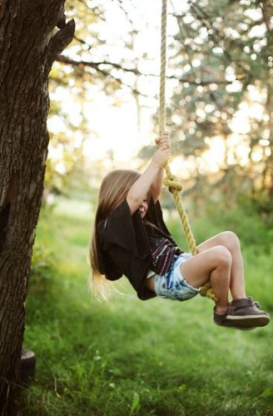
The vegetable garden was at the front of the old house, on the other side of the driveway, and so offered a splendid view of the Third Line, while I also glanced around at the long rows of flourishing plants, and decided where to begin my harvest.
I always began with the carrots first; something to snack on while I chose the rest of the vegetables.
I’d find the biggest one, grab it firmly, close to the ground, give it a good yank and wipe it off on the grass. I’d break off the spindly end, and bite down, and give some thought to the next carrot that I would pull for our salad. I’d pull about three large ones, and then move onto the lettuce. Sometimes the lettuce was chewed a bit at the edges, so I’d try to find some perfect leaves that were all intact and pick a bunch of those.

Tomatoes were next, and I’d look for the reddest, ripest and largest to add to my plastic bowl. We usually grew ‘Beefsteak’ tomatoes, and they were juicy, flavourful and delicious on thick, toasted slices of Mother’s homemade bread.
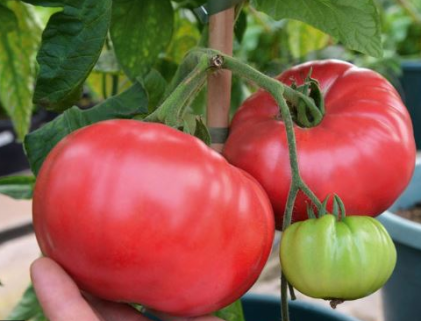
I would continue down the rows, breaking off one green pepper, and one ripe cucumber, then pull about four bunches of green onions from the ground. Sometimes Mother sliced the cucumbers and onions and soaked them in a glass of vinegar and water for a treat for us to have with supper.
The Dressing!Our food wasn’t fancy at home, but it was always fresh and Mother’s crowning glory for the salad was of course, her homemade dressing.
It was always a pleasure on those hot summer afternoons to go to our country garden, and marvel at the results of all of our hard work. The tiny seeds planted in the spring, along with the watering, weeding, and hoeing, had yielded these ripe and tasty vegetables for our table.
Though I’ve tasted many salads since those days so long ago, none could ever compare to the warm, ripe summer vegetables from our own country garden.

1 c white sugar
2 Tbsp. flour
1/4 tsp salt
1 c vinegar
1 egg
1 heaping tsp dry mustard
1 cup milk
Measure dry ingredients into a saucepan
Mix well
Add egg and mix into a paste
Add milk, and stir
Add vinegar and cook, stirring occasionally until it boils.
Cool, and serve
Use on garden salads, raw veggies as a dip, on toasted tomato sandwiches, and the Stafford family’s favourite – in potato salad!(Salad Dressing – from Recipes & Recollections: Treats and Tales from Our Mother’s Kitchen, ISBN 9780987702609, p. 132)
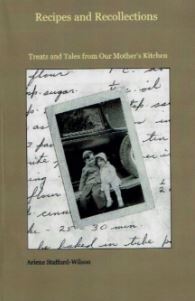
“Recipes and Recollections: Treats and Tales From Our Mother’s Kitchen”
Arlene Stafford-Wilson
August 8, 2022
Granny’s Afternoon Tea

Dorothy Woolsey Rutherford – (1893-1976) at the Stafford house
Afternoon Tea
on the Lawn
It must have been quite a sight for local farmers rumbling by on their tractors, heading back and forth between the Third and Fourth Line of Bathurst with full loads of summer hay. There she was, decked out in one of her fine silk dresses, with a strand of pearls and matching earrings, waiting patiently in a lawn chair for her afternoon tea.
Our Granny came for a visit from Edmonton every few years, and we all tried to make things as nice as possible for her stay. She often worried that she wouldn’t be able to sleep during her time with us, and so, one of my brothers was always tasked to visit the liquor store in Perth and purchase a bottle of her favourite cordial – Cherry Jack liqueur, which she claimed would help her drift off to sleep at night. It was not unusual at the end of her stay for Granny to leave the entire bottle untouched, as she claimed that it was so quiet and peaceful at our house, with the gentle rustling of the maple leaves and the sound of the crickets to lull her to sleep.
Apart from her request for the Cherry Jack, Granny was accustomed to having afternoon tea. Born in Lincolnshire, England, in 1893, Granny grew up in comfortable circumstances. Her family owned two successful butcher shops in Huddersfield, her maternal grandparents, the Fosters, owned butcher shops in Grantham, and her paternal grandfather was the owner of Woolsey’s Silversmiths and Jewellers, also in Grantham. Her family summered in Blackpool, England, a resort town on the northwest coast, and she and her siblings had a proper Victorian upbringing, enjoying certain daily rituals, like afternoon tea.
It’s been said that it was the seventh Duchess of Bedford, one of Queen Victoria’s ladies-in-waiting who started the custom, sometime around 1840. City dwellers who benefited from the new invention of gas-powered street lights, began to stretch their dinner hour later and later into the evenings, sometimes as late as 8 p.m. or 9 p.m.

7th Duchess of Bedford, Anna Russell
The Duchess often described feeling peckish in the late afternoon, and began to request that her maid bring bread, butter, jam, cake, and tea to her room, around 4 p.m. each day, and from this habit a tradition was born. The upper classes seldom needed an excuse to have another slice of cake or another cup of tea, and so the custom spread quickly across Britain.

The ritual of afternoon tea for the wealthy came with a number of accessories. Fine porcelain cups became the standard, with matching saucers, special tea-sized plates, sterling silver tea pots with matching cream and sugar servers. Names like Royal Crown Derby, Wedgwood, and Spode, and in later years Royal Doulton, and Royal Albert were the usual suppliers of these fine china sets, often trimmed with genuine gold. Linens were also important, as were the types and blends of teas available, and the variety of condiments like potted jams and honey.
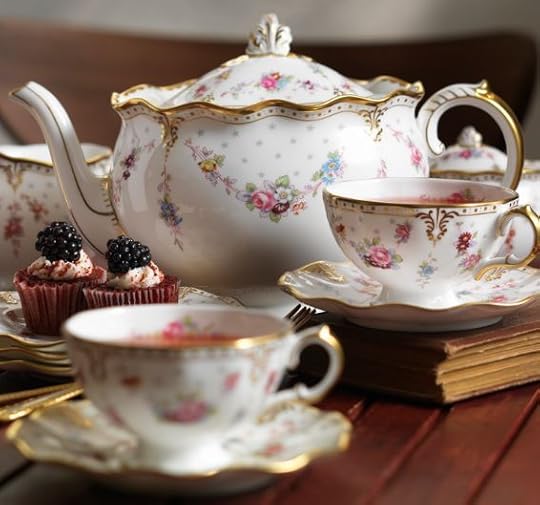
“Royal Antoinette” pattern, by Royal Crown Derby
There was also an important social aspect of afternoon tea, and the way in which women could entertain at home, and were free to exchange ideas, opinions, and share their views on topics ranging from the domestic, to the religious, and the political. Tea dresses became fashionable and didn’t contain the usual restrictive boning, but were more free-flowing and comfortable, often made of lighter fabrics.

Tea Sandwiches
One of Granny’s favourites at tea-time were dainty cucumber sandwiches, cut on the diagonal, with the crusts removed. Long, thin English cucumbers are peeled and sliced paper-thin. Soft, thin slices of white bread are spread lightly with plain cream cheese and a layer of thin cucumber slices are lightly seasoned with salt and pepper. Tiny sprigs of dill or mint leaves may be used as a garnish.
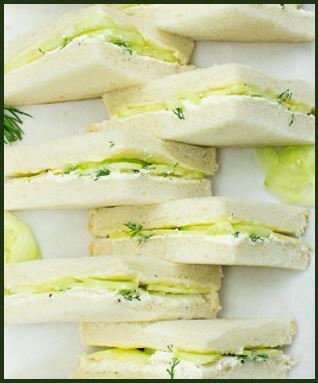
Traditional cucumber tea-sandwiches
Tea sandwiches at the Stafford house were often served on a Lazy Susan, a three-tiered serving tray, sometimes made of silver, or fine china. Mother made several different types of tea sandwiches – Pinwheel, Ribbon – with several alternating layers, Checkerboard – with two different colours of bread, and Open-Faced – a circle of bread (she used a water glass to cut the slice) topped with a filling and a garnish. Fillings were finely chopped egg salad, ham salad, salmon salad, cream cheese with maraschino cherries. Garnishes were tiny springs of parsley, and sometimes radish roses, and carrot-curls were placed on the plate as decoration.
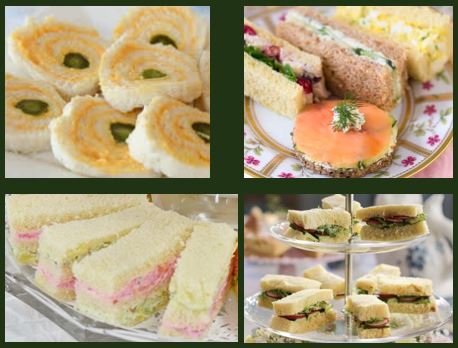
Pastries and Sweets
Granny’s favourites were the small Jam Pastries. Whenever Mother baked pies, (which was often) she saved the scraps of pastry, rolled them flat, cut them in circles or other shapes, placed a dollop of homemade jam in the center, folded it over, then sealed the edges with a fork tine. Mother also made bite-sized jam tarts, and dainty Cherry Balls, for a sweets-tray that was pleasing to the eye as well as the stomach. (recipe below)
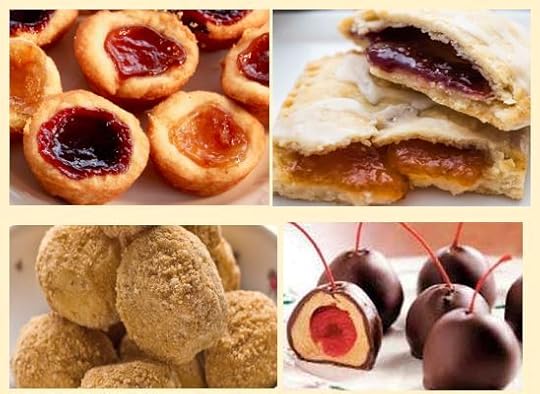
Mother’s Cherry Balls
1/2 c softened butter
1 1/2 c icing sugar
1 1/2 c desiccated coconut
1 Tbsp milk
1/2 tsp vanilla
a pinch of salt
graham wafer crumbs
maraschino cherries
Method: Mix well and shape around a drained cherry, then roll into graham crumbs
For variety, may be dipped in melted chocolate.
Chill on a cookie sheet, and serve. May be frozen.
The Tea
While Mother preferred Orange Pekoe tea, and drank Red Rose brand daily, our Granny drank English Breakfast Tea – a full-bodied black tea, and Earl Grey Tea – with the essence of bergamot. At one time the Red Rose company included a small ceramic figurine in each box of their tea, and perhaps that was part of their popularity with Mother. I remember seeing dozens of the little figurines here and there, around our house, in shapes of small animals and nursery rhyme characters.
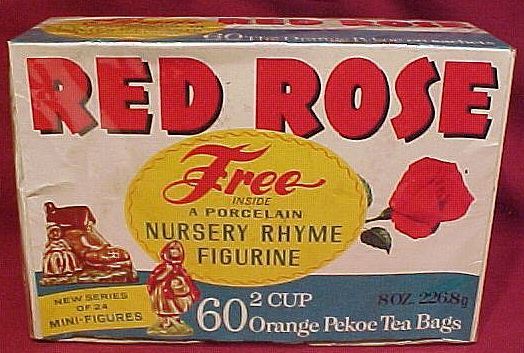
(Tea Bags were invented in the United States in 1908, but they did not become popular in England until the 1950s.)
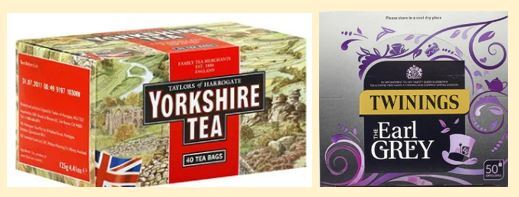

Tea bags, or loose tea in an Infuser
Brewing Tea
Fresh Water
It’s important to use fresh water when making tea. We were fortunate at home to have well water, but if you don’t then bottled spring water will do. If there is an ‘off’ taste or chlorine in the water then it will affect the flavour of the cup of tea.
Choose Your Pot
Traditional tea was made in a silver pot, and metal will keep the water hot longer, but a china pot will retain the flavour better.
“The First Cup is For the Pot.”
After the water reaches a rolling boil, the first cup of water should be poured into the pot and swirled around and then poured out. Our Dad always said, “The first cup is for the pot.” This helps to maintain the temperature.
The remaining boiling water is poured into the pot over the loose leaves, or the tea infuser, or the bag (bags), and allowed to brew for three to five minutes
Loose brewed tea is poured into the cup, through a tea strainer placed over the top of the cup. Infusers or tea bags should be removed once the tea has reached the desired strength.

Silver tea strainer – 1930s
Tea Cozy
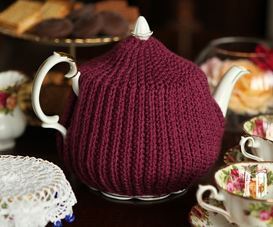
A tea cozy may be placed over the pot to keep the tea warm. Mother made crocheted tea cozies to give as gifts, and would often inquire about the recipient’s china pattern, then she would match the cozy to the main china colour.
Milk or Sugar?
Some drink their tea black, or with a dollop of honey, or a squeeze of lemon.
Our Granny preferred to take her tea with a splash of milk. The milk was always poured in the cup before the tea, so that the delicate bone china cup would not crack or shatter.
The British began adding sugar to their tea between the 17th and the early 18th century. At this time, sugar was being used to enhance the flavour of other foods among the upper classes and was thought of as an ostentatious luxury. At that time both tea and sugar had status implications, so it made sense to drink them together.
Tea Times – What to Expect:
A ‘Cream’ Tea — This is a simple tea with biscuits, scones, clotted cream, marmalade sometimes lemon curd and tea.
A ‘Low Tea/Afternoon Tea‘ — This is a light afternoon meal with small crustless ‘finger’ sandwiches, 2-3 sweets and tea. This is the one our Granny enjoyed on the lawns of the Stafford house. It’s known as “low tea” because guests are seated in low chairs with side-tables on which to place their cups and saucers.
High Tea – A ‘High’ tea consists of meat and potatoes as well as other foods and tea. Families with servants often took high tea on Sundays in order to allow the maids and butlers time to go to church and not worry about cooking an evening meal for the family.
Dreaming of England
As a child, I sometimes wondered if Granny missed her life in England, her childhood in Gainsborough, and her youth in Huddersfield. Did she dream of the elaborate silver tea settings crafted in her grandfather’s shop, and did she miss the elegant table settings, dainty afternoon delicacies, and the impeccable service by their family’s domestics?
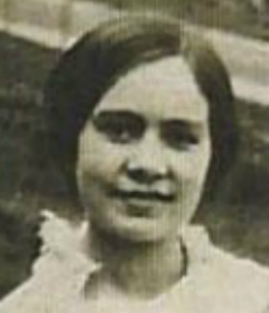
Dorothy Woolsey Rutherford
I like to think that Granny enjoyed the times spent at the Stafford house, sitting under the tall sprawling maple trees on warm summer days, enjoying her afternoon tea in our yard.

The Stafford House, Tay Valley Township, Lanark County, Ontario, Canada
Whenever Granny stayed with us Mother made delicious tea sandwiches that were as pleasing to the eye as they were to our taste buds. Her sandwich fillings were seasoned to perfection, and the small sweets and pastries were just the right finish to an afternoon tea.
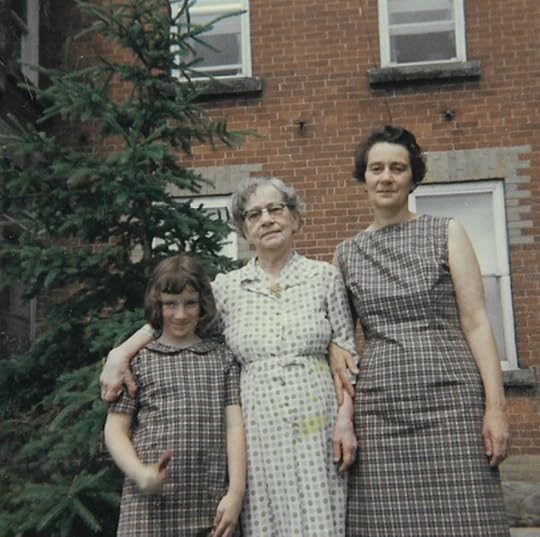
Arlene Stafford-Wilson, Dorothy Woolsey Rutherford, and Audry Rutherford Stafford – 1965 at the Stafford house
Enjoy Your Own
Afternoon Tea
This lovely daily ritual needn’t be expensive, and takes very little time to prepare. Simple fillings of egg, ham, or salmon salad can be prepared ahead of time, and a few small pastries or chocolate coated biscuits will do nicely. The tea of your choice may be one you’ve enjoyed for years, or you might like to experiment and try some new varieties. Perhaps you already have some lovely fine china that’s been passed down in the family to use for your tea service. Many swear that tea tastes better served in a fine bone china tea-cup.
In a busy world, where sometimes the news is less than cheerful, taking a few minutes for ourselves with a small daily ritual might be just the thing to brighten our spirits.
If weather permits, take your afternoon tea outside, and invite a friend or neighbour. Breathe in the fresh air, marvel at the beauty of the colourful flowers in your garden, or the clear blue skies overhead. A colourful bouquet at the table adds a nice touch.
For a meager amount of expense and preparation, the simple pleasures and contentment of enjoying afternoon tea is truly priceless. Make some lasting memories with your children and grandchildren, just as I did, so many years ago, on our front lawn, sharing afternoon tea with Granny.
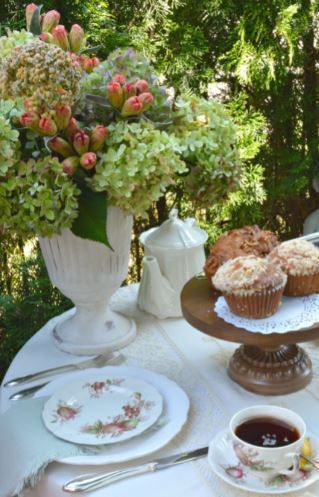

Arlene Stafford-Wilson
August 4, 2022
Rideau Ferry – Old Days
Ferry’s John Oliver One of Rideau’s Colourful Characters
The History of Rideau Ferry was compiled by Mrs. E.W. Joynt of Lombardy, assisted by Mrs. Wm. J. McLean, R.R. 5, Perth, and submitted to “The Perth Courier” by Mrs. Mary Armstrong, R.R. 3, Smiths Falls. The history was written in about 1965.

Rideau Ferry – 1912 – Coutts House in the background
“In the Township of Beckwith in Lanark County, Upper Canada, Ontario was one of the earliest settlements of which we read. Settlers arrived here from the Old Lands “to carve out for themselves and their children homes in the dense forests where churches, schools and modern conveniences were unknown. Log homes arose, tiny settlements took shape, and the need for spiritual guidance was recognized by these God-fearing people. So it was that following a petition from the people in the year 1821, the Presbytery of Edinburgh sent out the Rev. George Buchanan from Cuper Angus, Scotland.
Rev. Buchanan was a graduate in medicine and a licentiate of the Associated Presbyterian Synod. He sailed from Greenoch, Scotland in May 1822 with his wife and ten children. An ocean voyage of 36 days brought them to Quebec, thence to Brockville and on to the village of Franktown.
In 1826, his third daughter, Elizabeth, married Archibald Campbell of Rideau (Oliver’s) Ferry. The Campbell’s were pioneers in Lanark County, influential, progressive and respected. They lived in a frame house built in 1853 on the north side of the Rideau Lake. The marriage was blessed with four daughters: Ann, Margaret, Helen, and Elizabeth. Previous to this they lived in a log house.
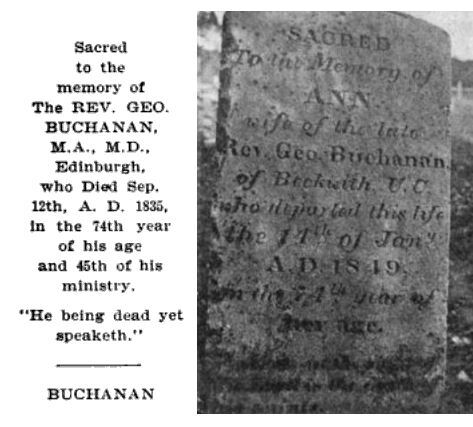
Rev. George Buchanan – the “old Presbyterian burial grounds”, Perth, Ontario
In 1843 Peter Coutts of Bendochy Presbytery of Meiga, Perthshire, in Scotland arrived in Ontario. Just where they settled is unknown, probably in Lanark County where he would have to make a home for his wife and six children, 3 boys and 3 girls. John the eldest was 12 years of age when he came to this country. When the family grew up he and his brother James settled in North Elmsley. John bought a farm from Duncan Campbell. When Duncan Campbell lived there he lived in a stone house near Rideau Lake which was burned down.

Rideau Ferry 1908
On Dec. 16, 1856, Helen Buchanan Campbell, 2nd daughter of Archibald Campbell was married to John Coutts a son of Peter Coutts. They made their home in a log house on Lot 22 Con. 6, North Elmsley. This land remained in the Coutts name until 1961. Here the family of 3 sons and 3 daughters were born. Archie, the 3rd son, married and spent his lifetime there. In 1896 he built a red brick house, a comfortable farm home which was later owned by his son Ross. In Jan. 1860 at the age of 96 Archibald Coutts died after a life of industry and Christian endeavour. In 1870 Archie’s parents Mr. and Mrs. John Coutts moved from their log home to a frame house near the Rideau Ferry; this house had been built by Mrs. Coutts’ father, Archibald Campbell in 1853. In the years to be, this place became widely known as the ‘Coutts House”.
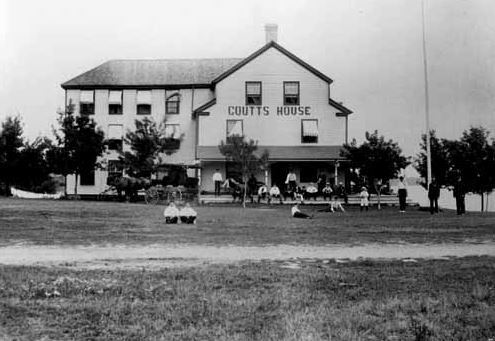
Coutt’s House, Rideau Ferry
In these early days men walked to Brockville and back again carrying bags of wheat to have it ground into flour. Since there was not a bridge to connect the road from Brockville to Perth, Mr. A. Campbell decided to build a scow. This was a large, flat-bottomed boat, propelled by oars and a cable and was used to transport or ‘ferry’ horses, cattle and produce across the waterway.
For a number of years it was termed “Oliver’s Ferry”. The operator of the scow was one, John Oliver. He resided on the south side of the lake at the point where the scow made its crossings. He was a notorious character and the story is told that when travellers from Brockville or Perth remained at his home overnight they were robbed. His farm was sold to Joseph Thompson and then to Patrick Wills. It remains in the Wills family. Mr. Thompson’s wife was a daughter of Archibald Campbell.
In 1826 the construction of the Rideau Canal connecting Kingston to Ottawa (Bytown) the capital of Upper Canada was begun. During its construction history tells that in 1830 there were 1, 316 employed on the project between Kingston Mills and Newboro and that 500 of them died of malaria in that year. The work was completed by the end of 1831 and on May 21, 1832 the side wheeler “Pumper” made the first complete trip from Kingston to Ottawa passing enroute through the Rideau Ferry. Produce and goods of all kinds were transported over the waterway and this prompted Archibald Campbell to erect a wharf and warehouses at the lake front in 1832.

The “Pumper”, 1834, Archives of Ontario
He put teams and wagons on the roads carrying vast quantities of freight to and from the towns and villages in the surrounding district. These storehouses were a landmark and served the useful purpose of storing commodities of all kinds until the time came when other modes of transportation became more convenient. One of these buildings was then removed; sold to a farmer in the district who rebuilt it as a farm building.
Mr. Archibald Campbell died of cholera in 1834. His wife recovered from the dread disease and was spared to raise her family of four daughters. She carried on the business for many years until the building of the railroad from Brockville to Perth in 1859 diverted a good portion of the traffic. In 1875 Mrs. Campbell died and was buried beside her husband in the old burying grounds in Perth.
Mrs. A. Campbell’s properties included a brick house; this home was originally a frame dwelling located some distance from the Ferry on the Perth Road. Mrs. Campbell moved it near to the lake shore at the Ferry, enlarged and brick veneered it. This house was willed to Helen, Mrs. John Coutts; the frame house in which she lived was willed to Ann, Mrs. Henry Smith. Helen wished to conduct a boarding house and because the frame one was more suited to this purpose, she and Ann traded houses. This was the beginning of the “Coutts House”, as mentioned previously. This business grew into a fine summer hotel for folks, seeking pleasant recreation and leisure time.
In 1893 an addition was built to the back of the house. This consisted of three floors. The first floor was a large dining room and the second and third floors were 15 bedrooms and a bathroom, making 30 bedrooms in all. A well was drilled and a windmill erected so water was forced into the kitchen for cooking and drinking. Pipes were laid from the lake and the water forced to the top story by a force pump. Guests coming by train to Perth and Smiths Falls, a distance of 8 miles, were met by the proprietor with horse and buggy.

In 1888 the store and dwelling recently occupied by Mrs. Stewart was built by Mr. Peter Coutts, father of Mrs. Edward Joynt. During the summer home-made ice cream and ginger beer were made and sold in large quantities; crusty homemade bread from the family kitchen was sold at 6 cents a loaf. All types of fishing tackle, groceries and provisions found a ready sale.
About 1893, the telephone line was strung from Perth to Rideau Ferry. The first and only telephone was located in Mr. Coutt’s store. The ground wire was carried to the old graphite factory near the lake. Every month Mr. Coutts sent reports of all messages to Desoronto. The charge was not very high and the telephone booth was a busy place in the summer.
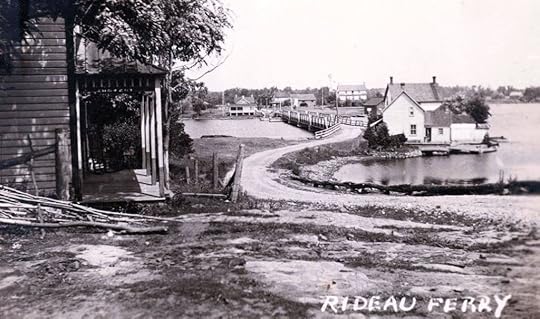
Mr. Peter Coutts moved into the Coutts House in 1898, and operated this busy place for 7 years. For several years after it was rented to various people until 1947 it was purchased by Mr. Wallace of Osgoode. He tore down the old wooden structure and replaced it with a modern one of cinder block construction.
On the first floor, bordered by a broad veranda is a huge dining room with large plate glass windows looking out over the lake. Above it is a dance floor where young folks enjoy modern dancing. The barns and stables at the back were torn down and a number of cabins were built. This has been sold and resold since the new building was erected. It is now operated by Jack Fitzgerald of Smiths Falls. A swimming pool was built in 1961 on the lawn facing the lake.

Rideau Ferry Inn 1947-1986
The mail for Rideau Ferry District arrived at the railway station at Port Elmsley, there to be picked up by a courier. Mrs. Wm. McCue, who brought it to his home in which the post office was situated. The Rideau Ferry Postmistress Mrs. Ann Campbell Smith, would drive her pony to McCue’s, receive her share from the mail bags and return to her office in the red brick house at the Ferry. The neighbourhood folk and summer tourists eagerly awaited their letters and papers. It is said that news items often reached the public via the penny post card and the Postmistress. In later years, a stage plying between Perth and the Rideau Ferry, driven by Samuel Hall, brough the mail bags and the other commodities to the post office and the village stores. This in turn was replaced by our modern rural mail delivery. The post office is now located in Mr. Stewart’s store.
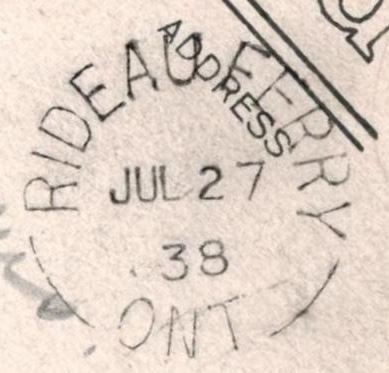
Postmark from the Rideau Ferry Post Office, 1938
A recent story about Rideau Ferry has just been found and follows, the composer of this is unknown:
In 1826 Archibald Campbell built a scow, as previously mentioned. This was operated by oars and cable under the management of a hired man named John Oliver; hence the name “Oliver’s Ferry”.
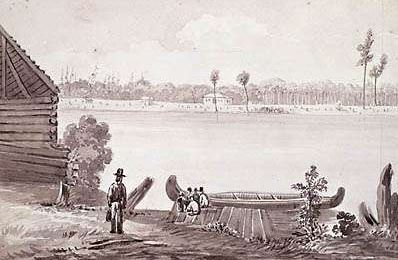
Oliver’s Ferry, 1830 – photo: Library and Archives Canada

Oliver’s Ferry, 1834, Rideau Lake, looking toward Bytown, photo:Ontario Archives
In 1844 Mrs. Anne Smith, living in a brick house near the bridge, owned a tract of land along the road on the east side and on the lake on the south side of this field. She had the field surveyed into lots and gave Oliver’s Ferry the name of Rideau Centre. To the year 1893 it was called Rideau Centre, but in 1909 it was called Rideau Ferry. So, between these years Mrs. Smith who was Postmistress had changed the name again. Mrs. Smith died Dec. 25, 1908. In 1909 her brick house was sold to James Allen of Perth. Mrs. W.S. Robertson of Perth bought four lots facing the lake; Mrs. Sam Hall bought the four acre field which has since been surveyed and divided among Mr. Hall’s family. Mrs. Max Hall built on his lot near the lake some years ago and still lives there.
In 1909 Mrs. Smith’s household effects were sold by auction. Of special interest was an antique chair of Spanish mahogany which she used in the post office. It may be seen in the museum in Perth Ontario now.
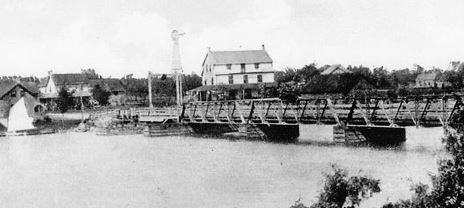
Rideau Ferry Bridge with new spans – 1896
In 1871, by joint auction of the Town of Perth and the Government of Canada, a substantial wooden bridge was built across the Rideau, thus ending the operation of the Ferry. In 1896, the first bridge was replaced with a 501 ft. iron bridge of two sections – one section which swings open allows the larger craft to go through.
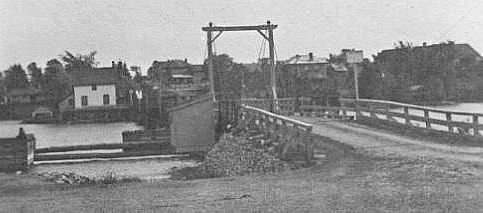
Rideau Ferry Bridge – 1918
The first Bridgemaster, working 24 hours a day was Duncan Campbell, a brother of Archibald Campbell. Their wives were the Buchanan sisters. Duncan lived in a frame house built in 1872 on the south end of the bridge, a house which still stands and is now remodelled as a summer home for the Campbell descendants.
The Bridgemaster is appointed by the Dept. of Transport of the Dominion government and now occupies the Government-owned red brick house at the north end of the bridge. This bridge stood the ravages of time until the summer of 1961 when a heavily loaded transport tank carrying caustic soda caused the collapse of one span. It was immediately replaced by another. A petition has been sent to the Dominion and Provincial governments urging them to replace this 67-year old structure with a modern one to accommodate the heavy flow of traffic. The present Bridgemaster is Mr. MacKenzie.

One of the early landmarks of this district was a flourishing lead mine, operating about one mile north of Rideau Ferry. A factory was built at the Ferry, and to it, teams drew the ore which was converted into graphite to be used in the manufacture of ammunition. Many of the employees boarded at the “Coutts House”. In later years the “Globe Graphite Company” erected a mill at Port Elmsley and the ore was taken there for processing. For many years the mill was idle, since it was not producing sufficient ore to make it a paying enterprise. In 1896 the 100’ long graphite factory was torn down. Robert Miller bought 60 ft. of this and Archie Coutts the remaining 40 ft. It is said that for many years the fine lead dust could be seen in the huge beams. A huge stone roller used to grind the ore, stands in front of the Ferry Inn. It is used as a base for the flag pole.

Rideau Ferry Inn

Rideau Ferry Inn
About the year 1898 Mrs. John Coutts retired from the “Coutts House”. On the site of the old factory he built a comfortable red brick house. He and his wife lived there for the rest of their lives cared for by their daughter. Mr. Coutts died in 1904 and his wife passed on three years later.
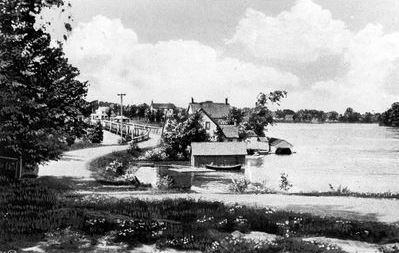
Rideau Ferry Bridge – 1935
As the towns grew and prospered, people began seeking more summer homes for pleasure and recreation. Summer homes were built along the picturesque shores of the lake as early as 1870. Names to be remembered are: the Bethunes, Senator Peter McLaren, F.W. Hall, C.J. Sewell, Lawrence Gemmill, Dr. A.E. Hanna of Perth, the John Dietrick family, the Charles Frost family of Smiths Falls. Guests at the “Coutts House” were the Ormes and Lindsays of Ottawa, J.H. Mendels of Smiths Falls, and many visitors from the United States. July and August were the busy months at the “Coutts House”, always a full house.
Life was a gay and interesting time. Pleasure boats from Perth and Smiths Falls transported moonlight and daytime excursions and sightseers; band music and sing-songs could be heard across the waters. Two boats from Kingston, “The Rideau King”, and the “Rideau Queen”, made regular trips between Ottawa and Kingston carrying passengers to summer homes and providing pleasure outings for organizations and groups of people from the cities.”
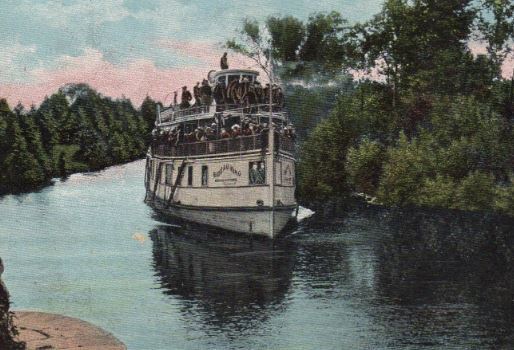
Rideau King
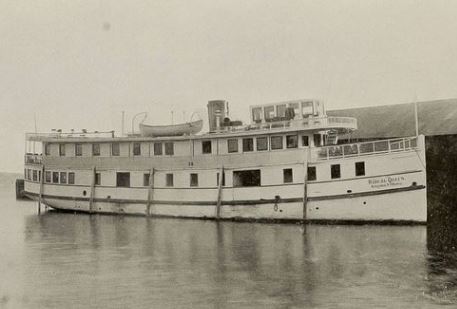
Rideau Queen – 1905

Rideau Queen – narrow hallway with cabins on each side
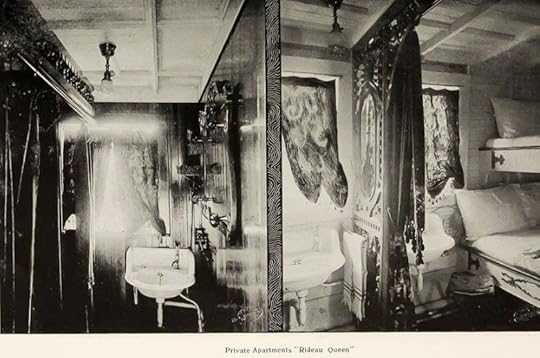
Rideau Queen – cabin and washroom

Rideau Queen lounge and piano parlor

Cabins and Guest House at the Rideau Ferry Inn
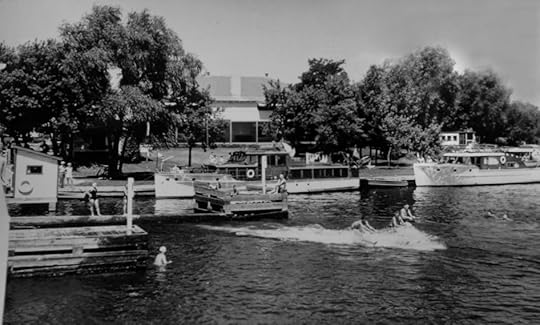
Water Skiing at Rideau Ferry
(Article from: May 26, 1982, p. 17 and p. 22, “The Perth Courier”, written by: Mrs. E.W. Joynt of Lombardy, assisted by Mrs. Wm. J. McLean, R.R. 5, Perth, c. 1965)
And so, the early days of Rideau Ferry, or Oliver’s Ferry as it was known were similar to many of the settlements built along waterways. From the days of the early ferry used to transport goods, through the times of establishing a post office, telephone service, building bridges, and eventually prosperity, partly from the influx of tourists and visitors who came for recreation along these peaceful shores.
Rideau Ferry will remain a place to pause along her magnificent waterways, and in the stillness and the beauty that surrounds you, feel the sense of her history, and the stories of those long-forgotten souls, who walked those same paths, so many years ago.

Arlene Stafford-Wilson

